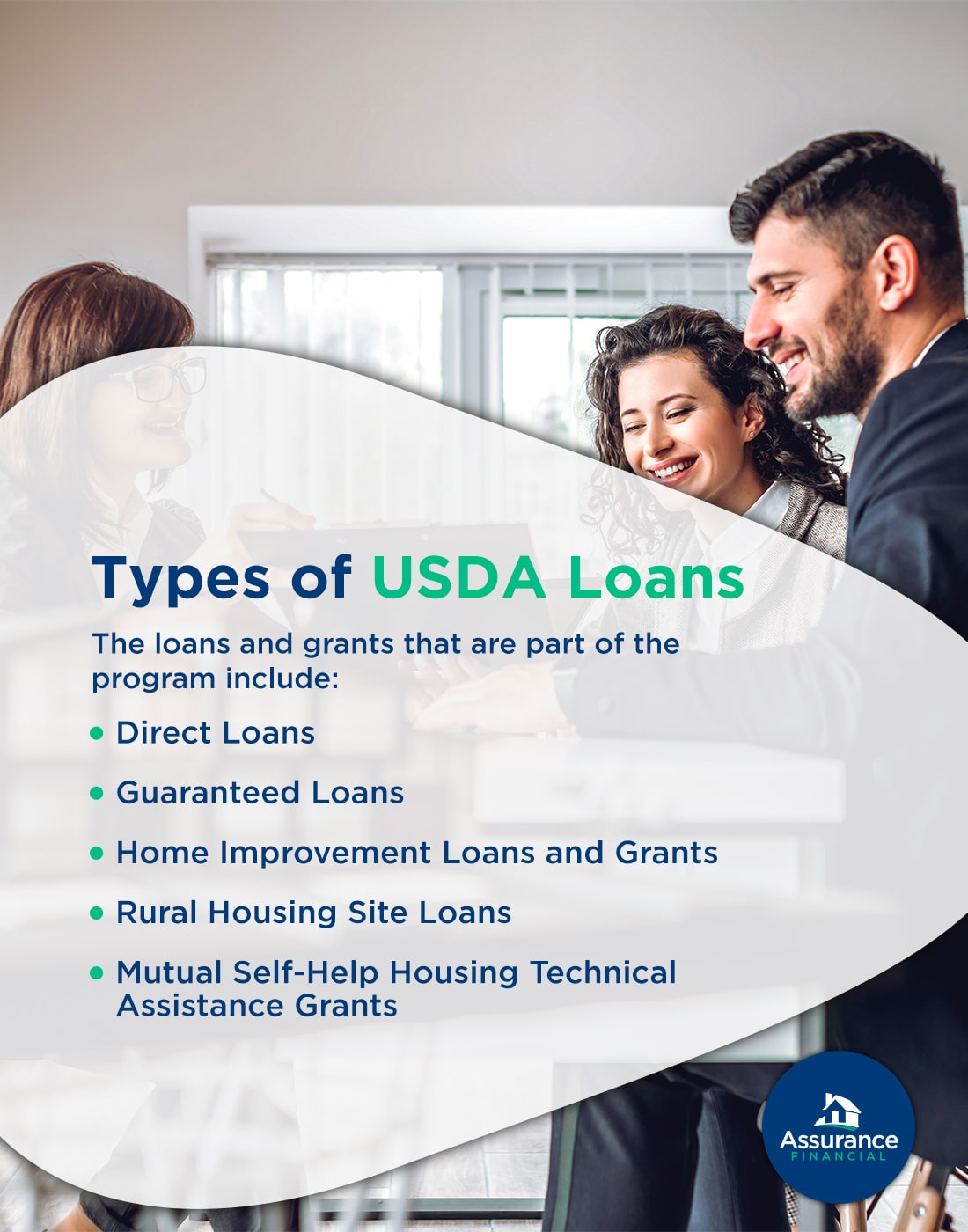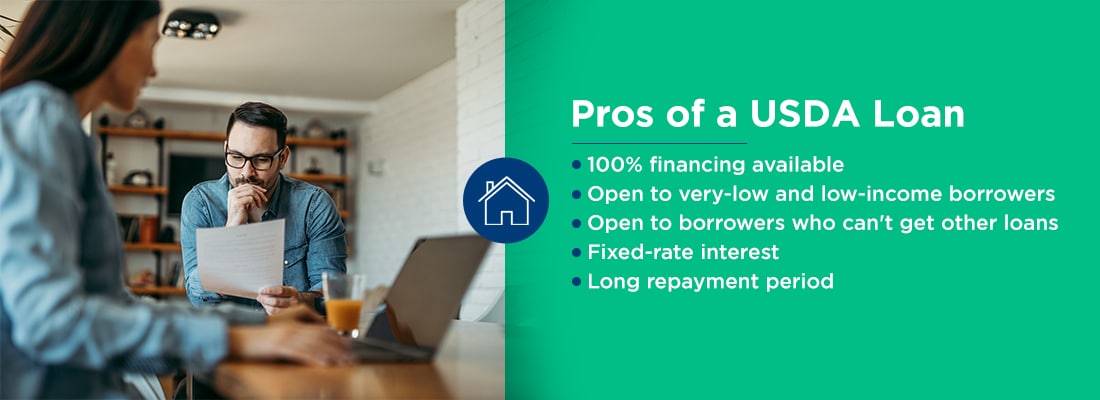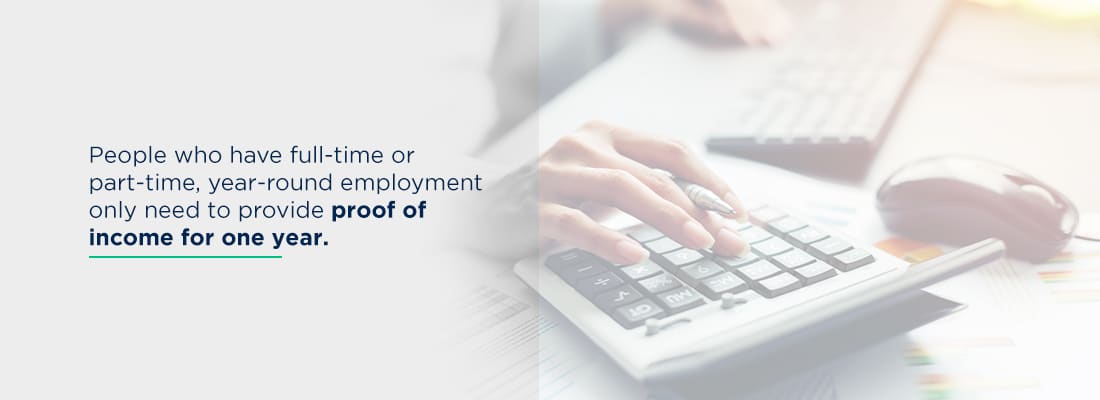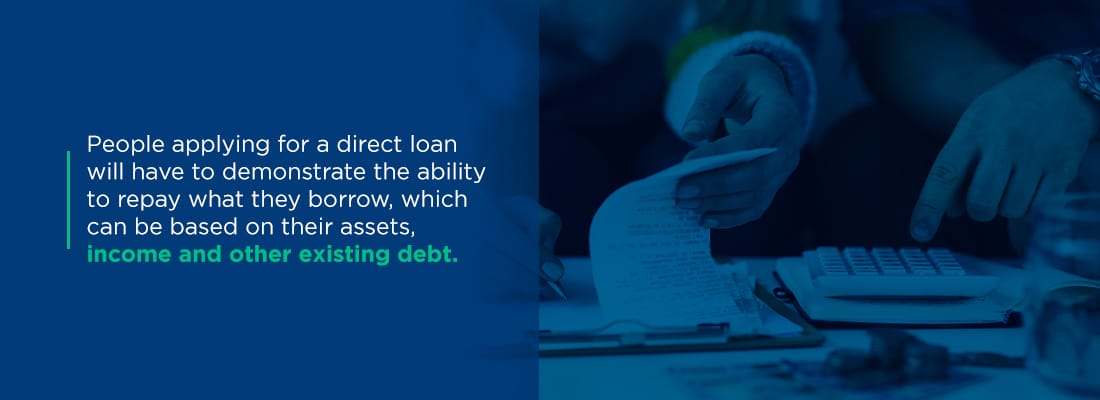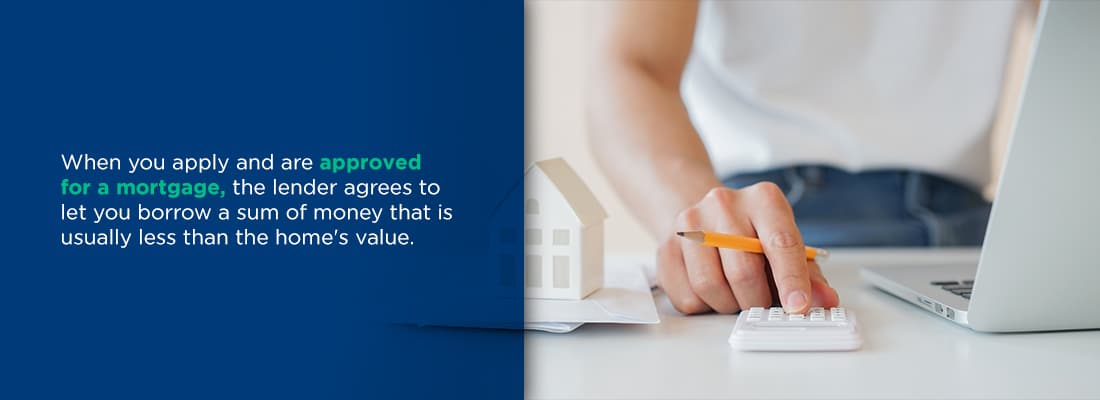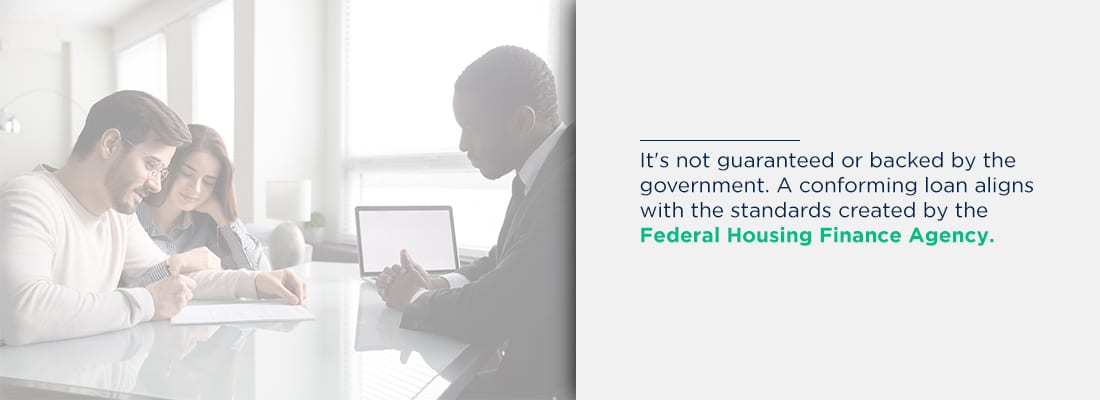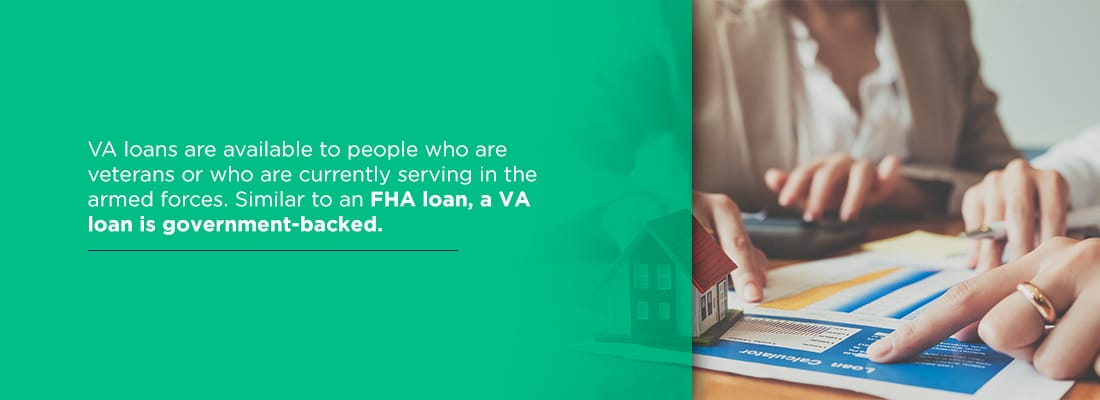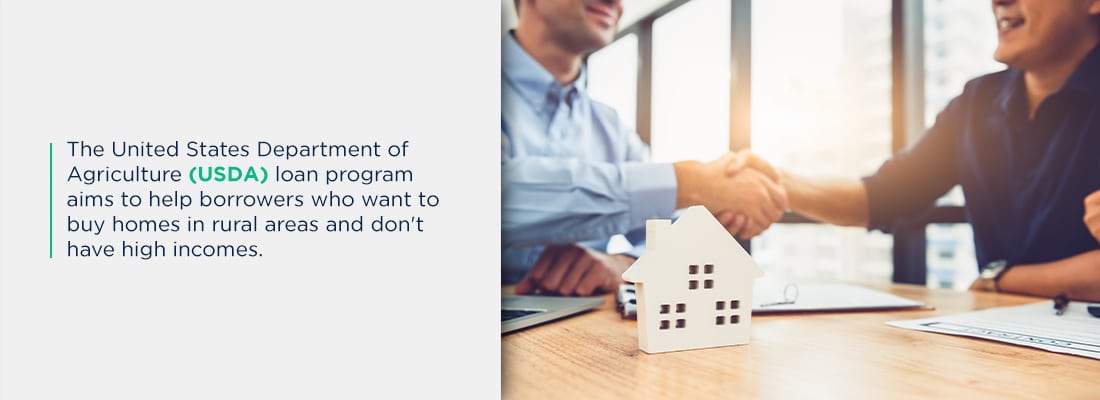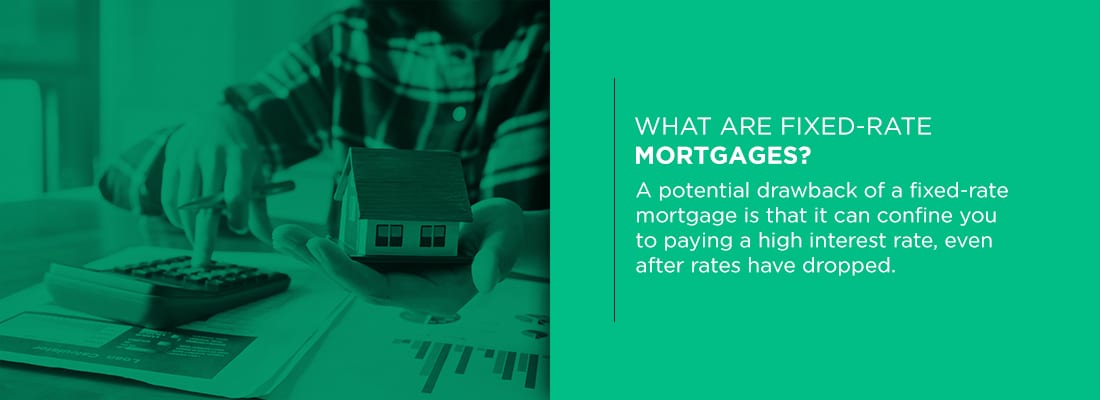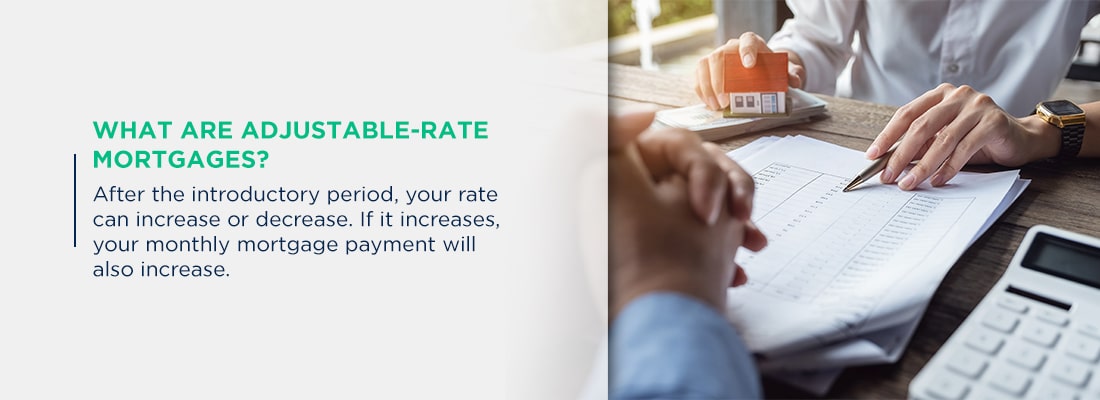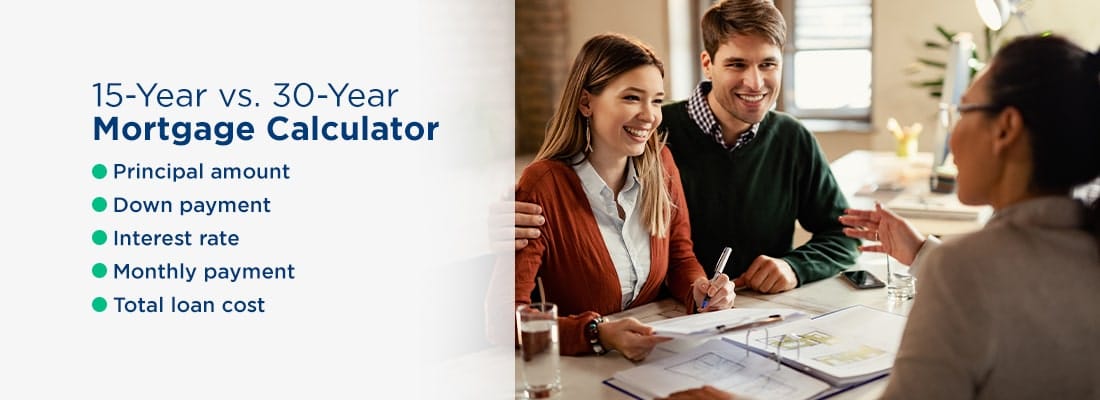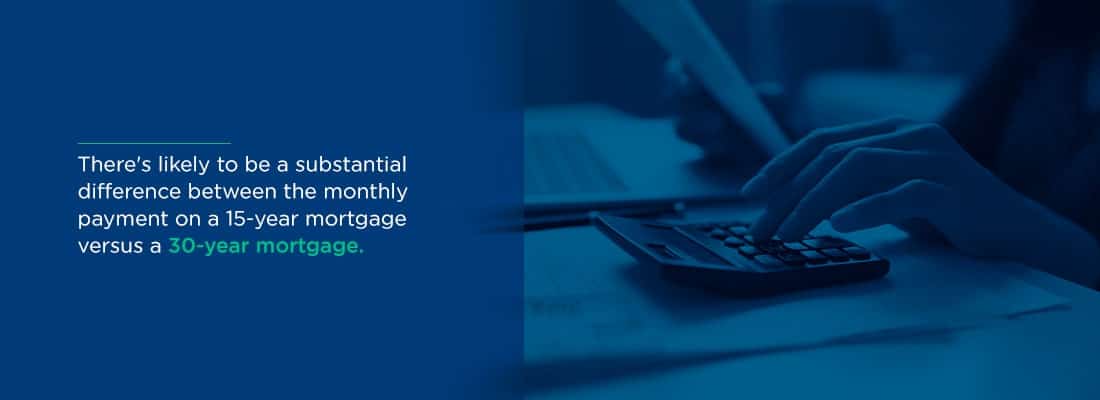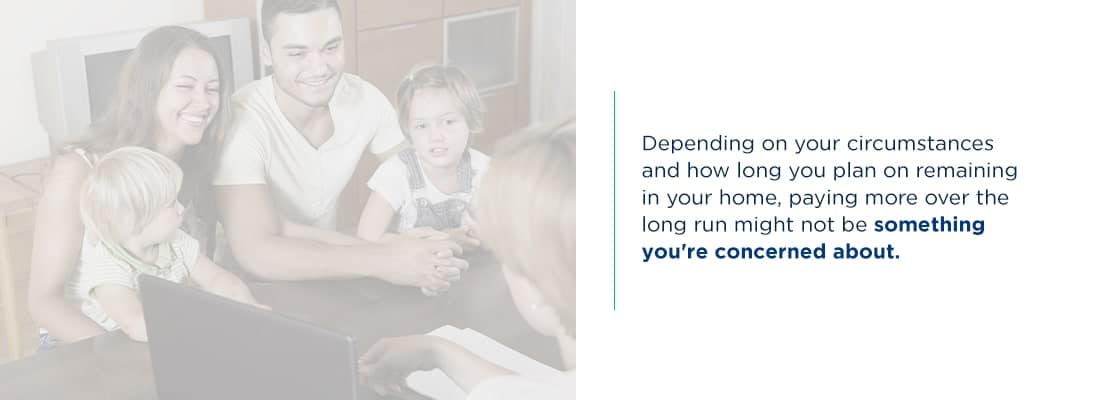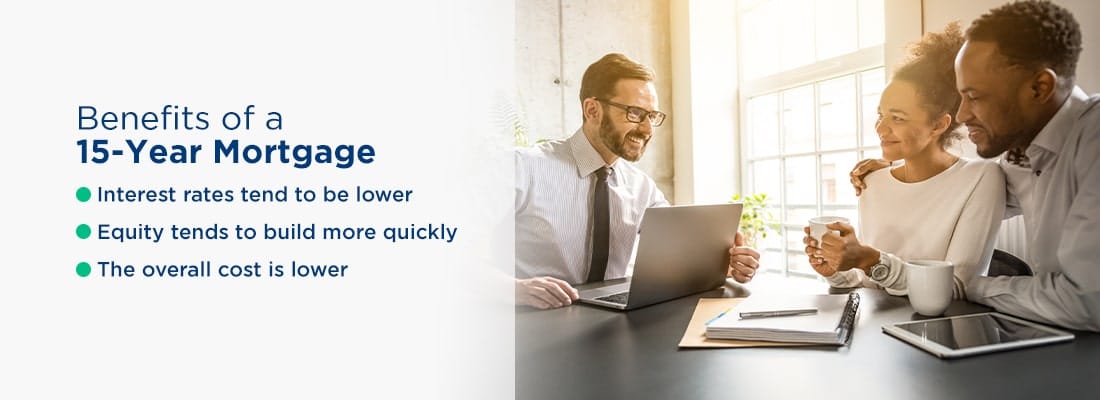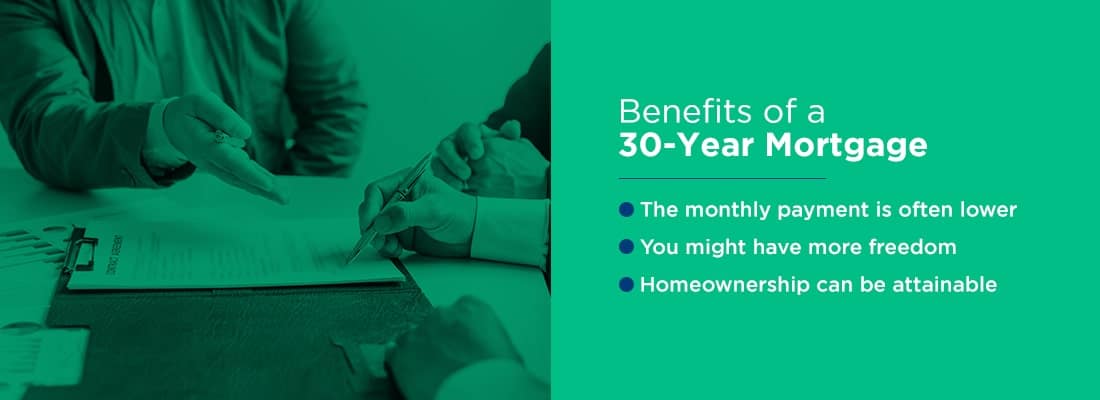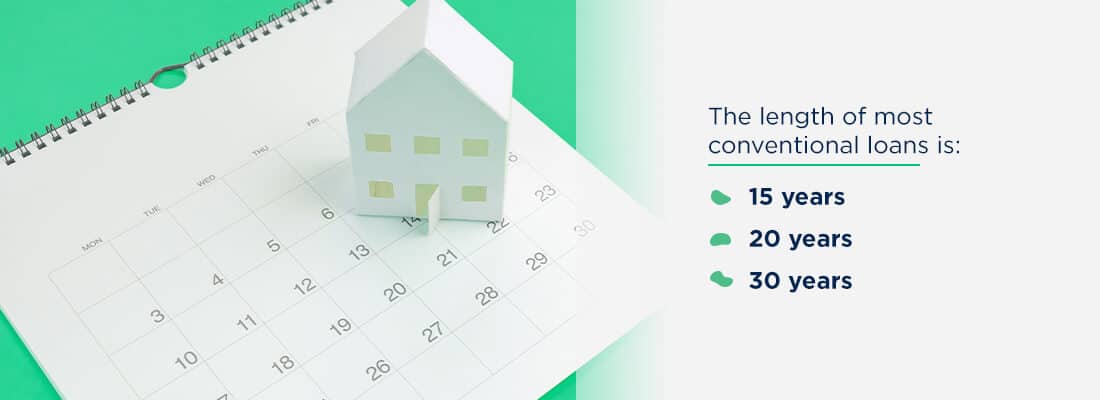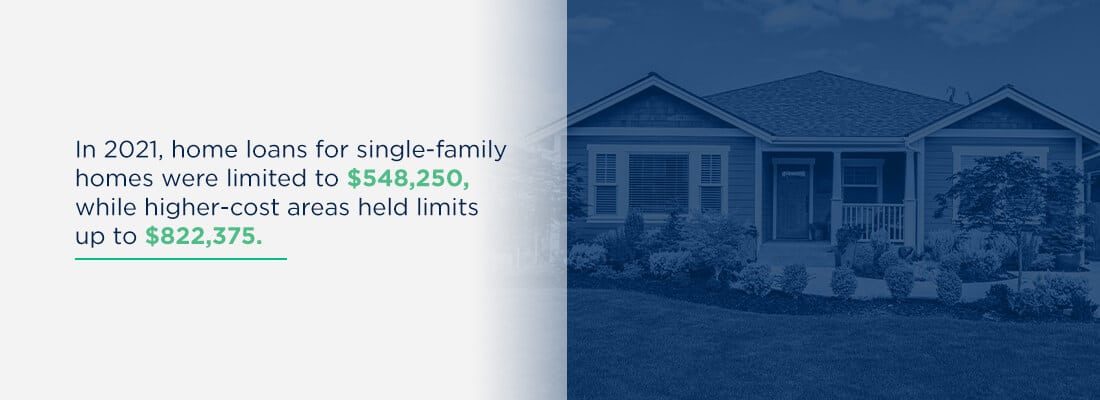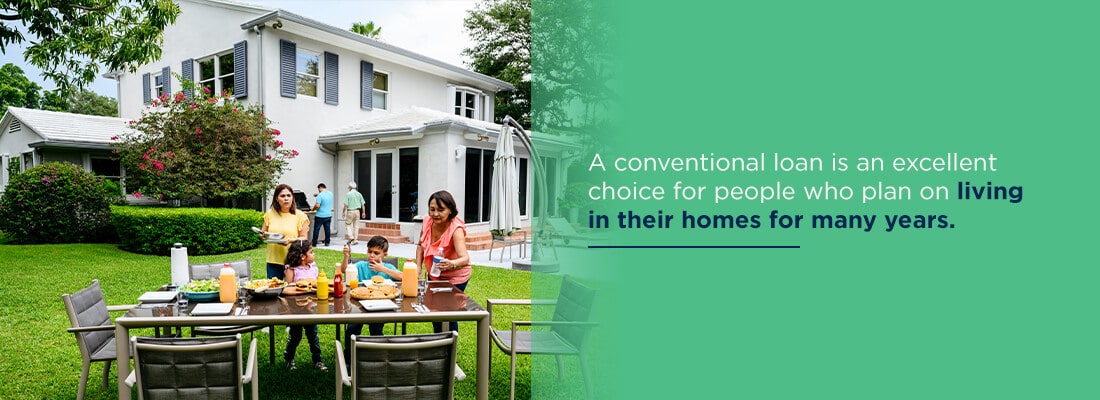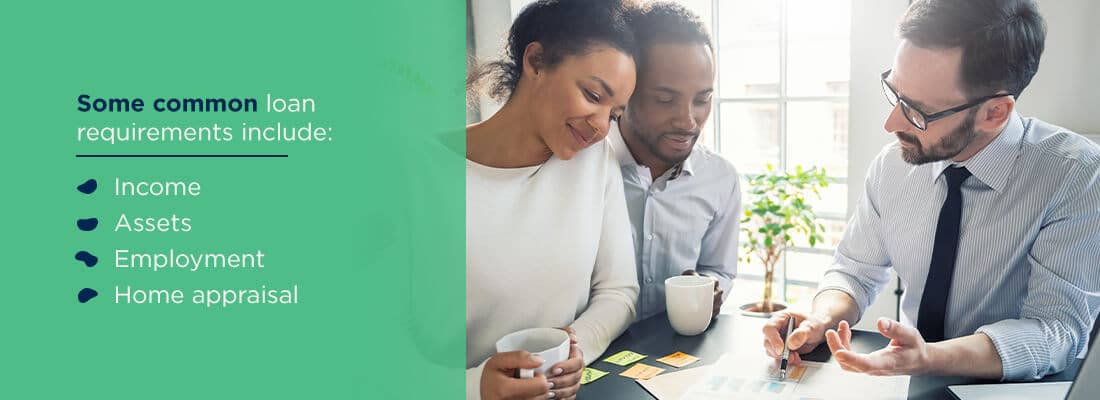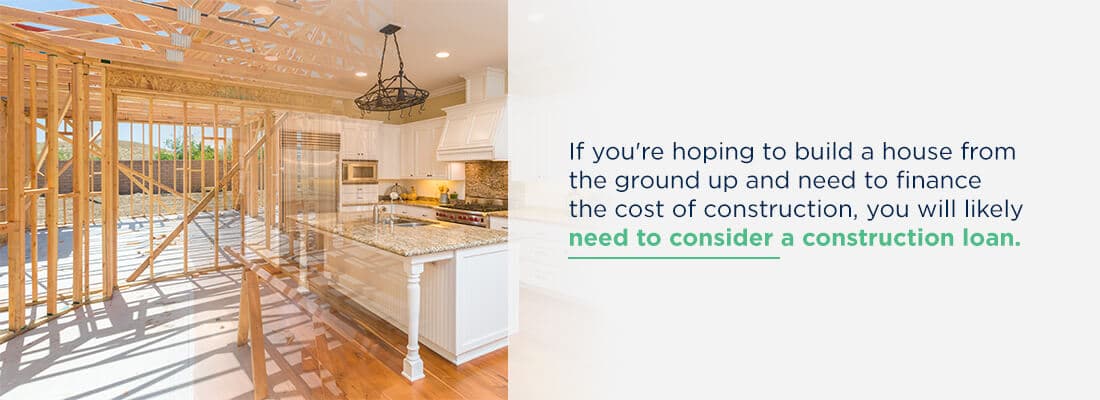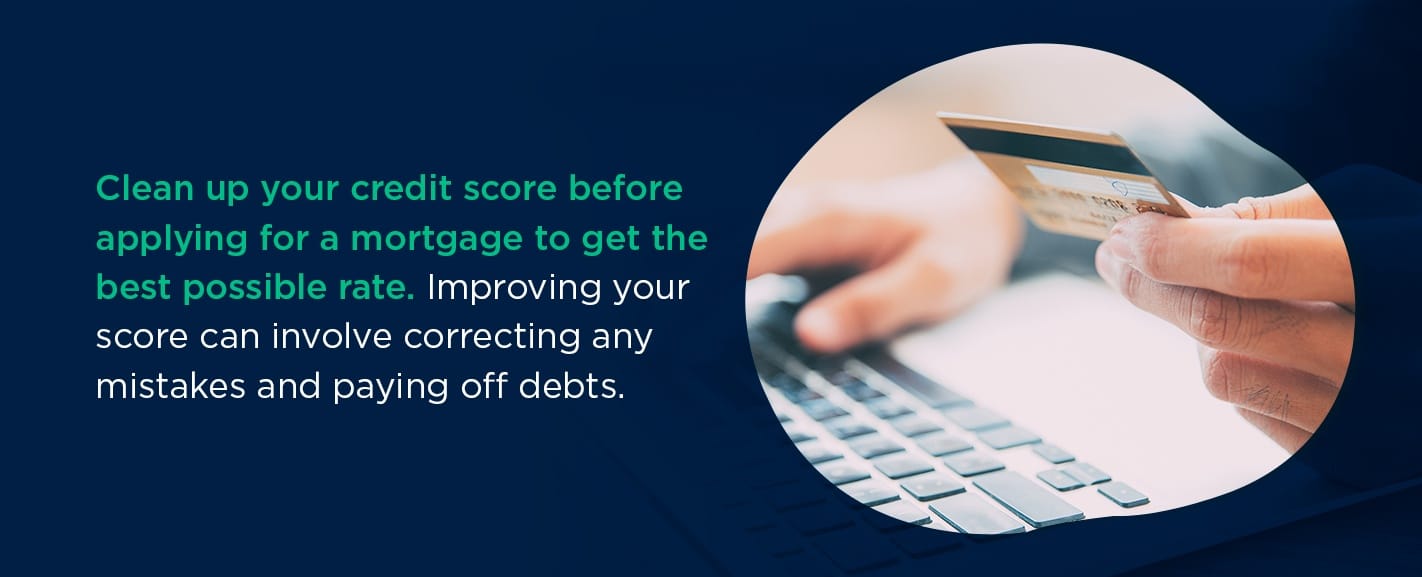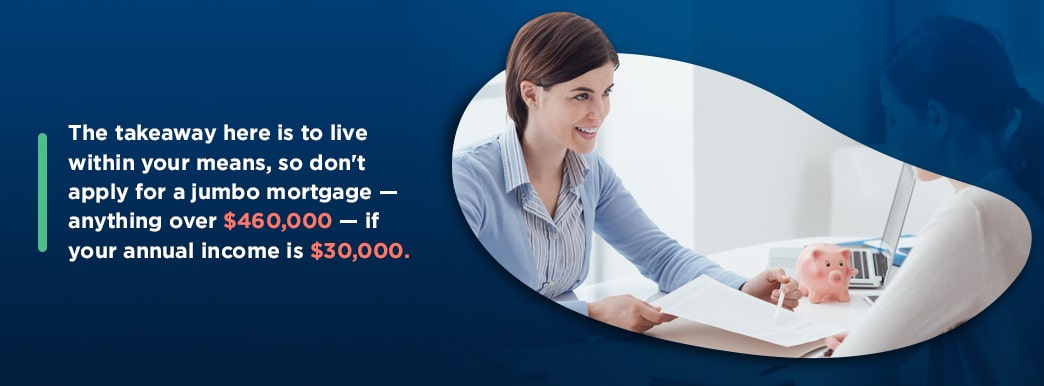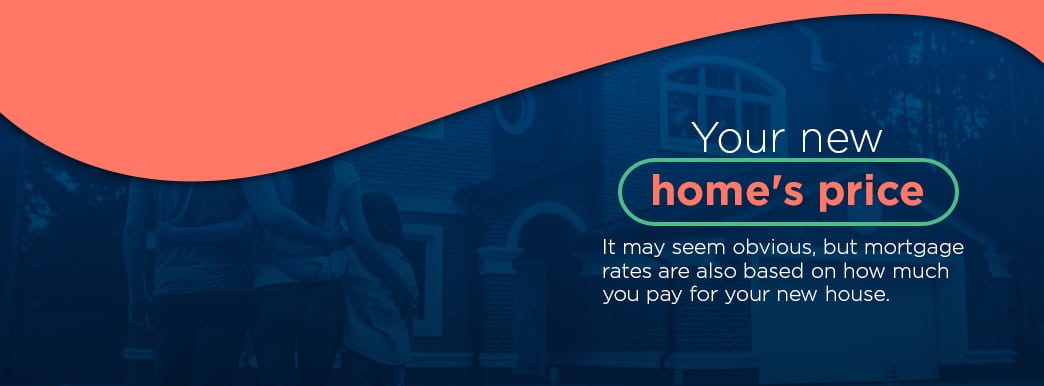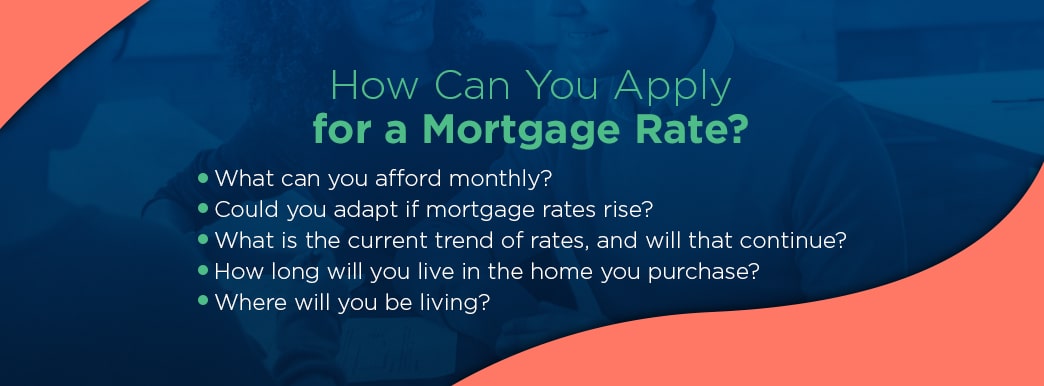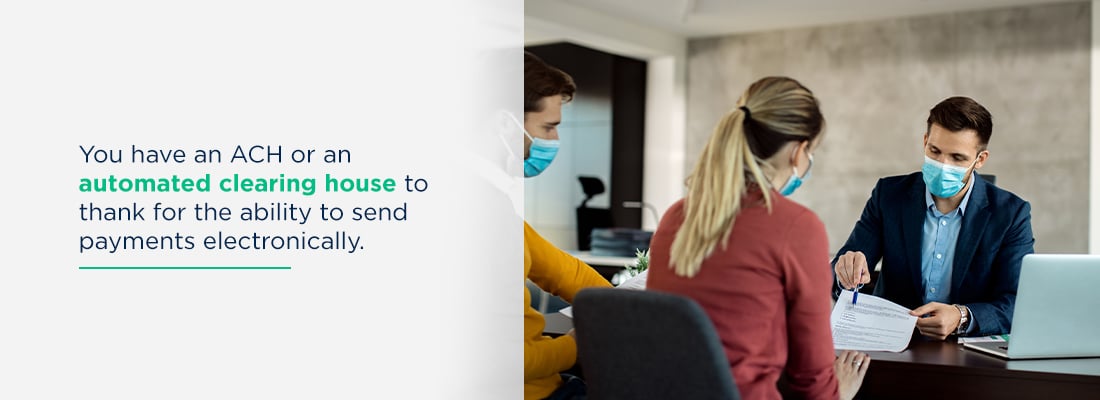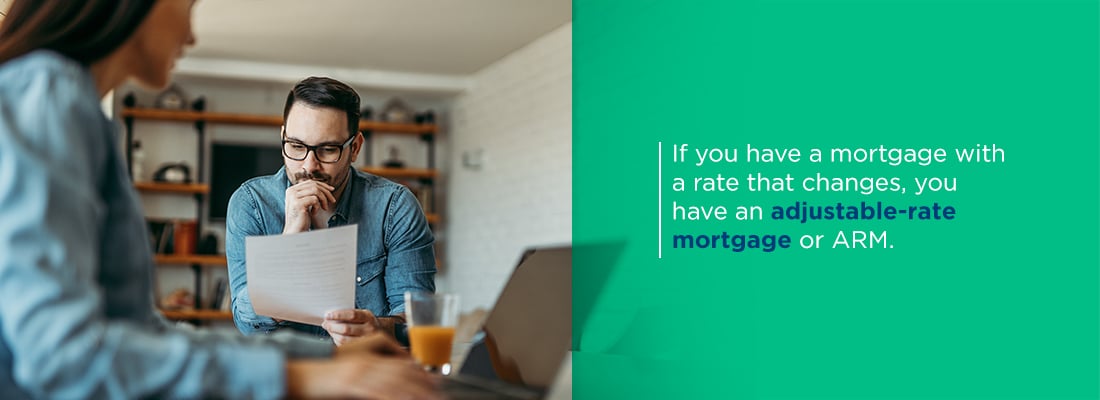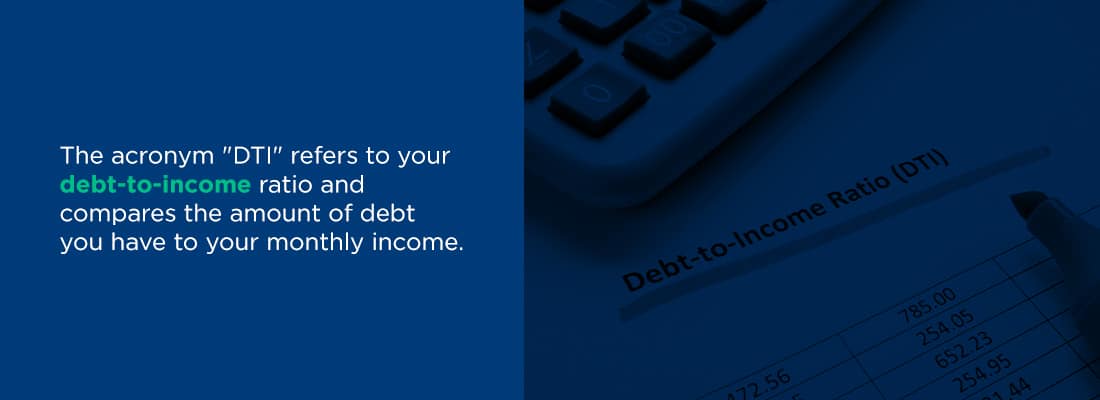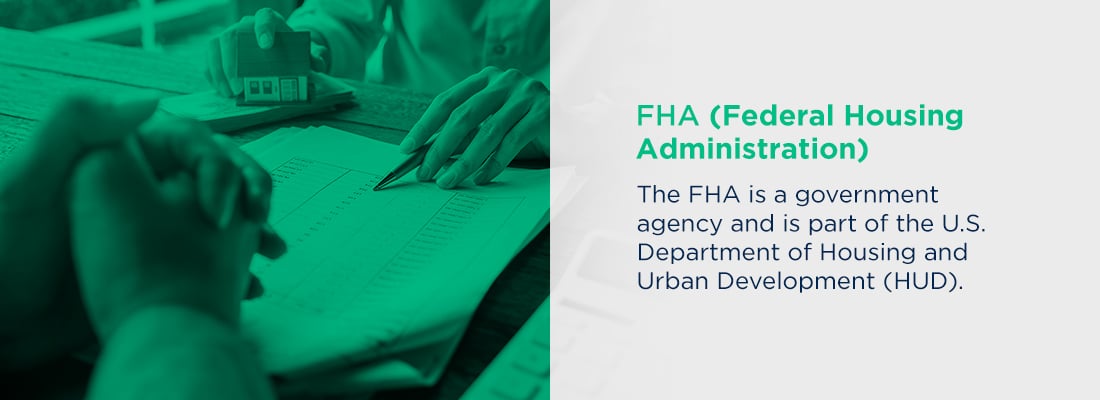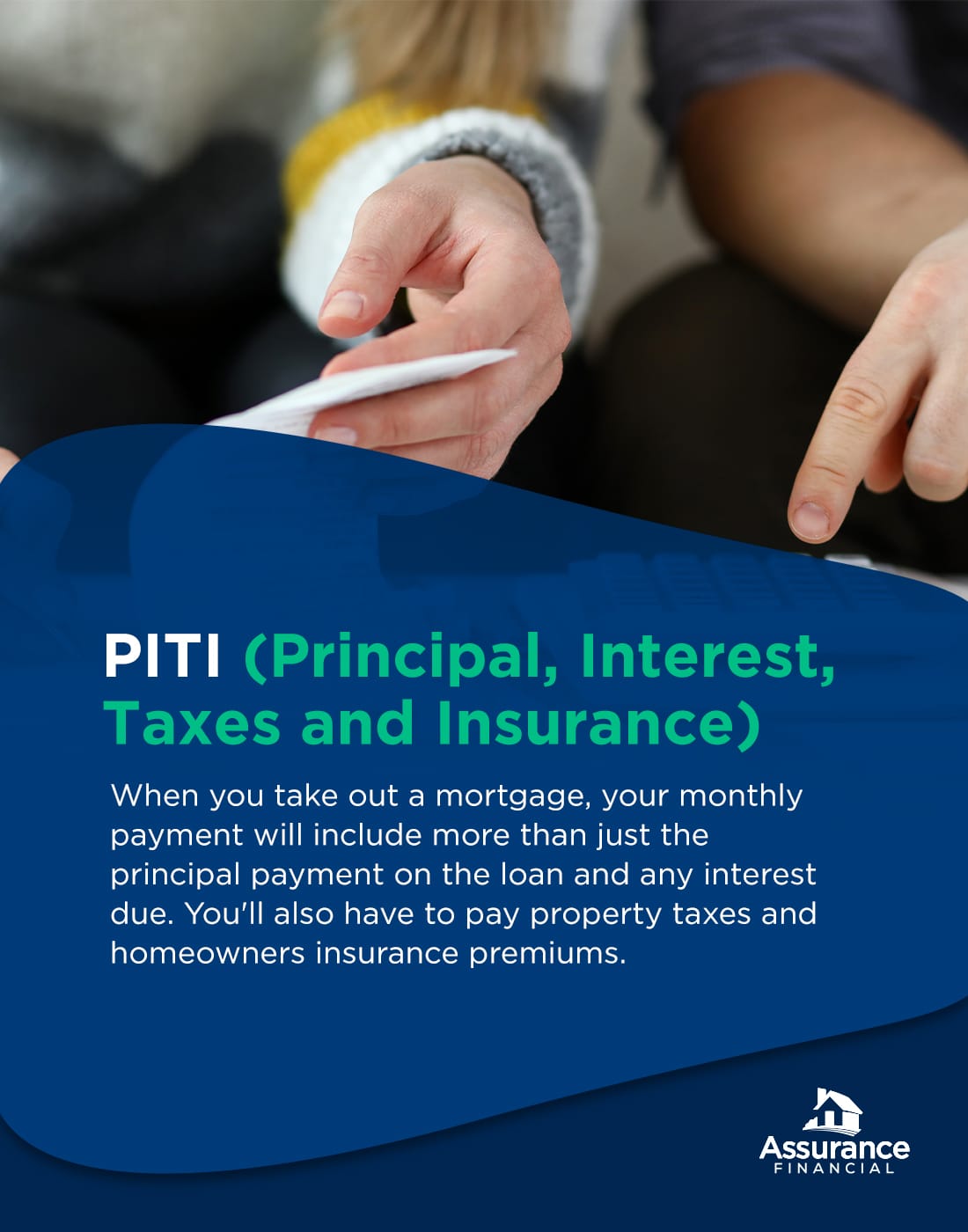Category: Loans
In the U.S., most of the population lives in urban areas. But for some people, living in a rural or country area is more appealing. If you prefer rural living over city life, a program from the United States Department of Agriculture (USDA) can help you buy a home. Every year, the USDA uses its Rural Development program to invest about $20 billion in helping families across the United States buy and improve their homes. The program was created to boost rural economies and improve quality of life.
Below we’ve mapped out an overview of the USDA Rural Development Guaranteed Housing Loan Program, explaining how it works and if you’re eligible for loans.
Topics Covered
- What Is a USDA Loan?
- Types of USDA Loans
- Who Should Get a USDA Loan?
- Pros and Cons of a USDA Loan
- Who Qualifies for a USDA Loan?
- Other Mortgage Options
What Is a USDA Loan?
The USDA loan program is part of the department’s single-family housing program. It aims to encourage the purchase of homes in rural or suburban areas by making mortgages easier for borrowers to obtain. Compared to conventional loans and other types of government-guaranteed loans, USDA loans have lower down payment requirements and lower income requirements. The loans also have strict income and location requirements.
USDA loans fall into several categories, with some only available to borrowers with the lowest incomes. The loans can be directly from the USDA or offered by private lenders and guaranteed by the department. The USDA’s Rural Development program also offers grants to individuals who want to work on housing construction projects.
Although the goal of the USDA loan program is to make homeownership more available to a wider swath of buyers, there are certain requirements people need to meet before they are eligible for the loans. The USDA’s programs have income limits and often have credit score requirements.
USDA loans are sometimes known as Section 502 loans. The mortgages seek to provide very-low to moderate-income buyers with access to sanitary, decent and safe housing in eligible areas.
Types of USDA Loans
The USDA’s Single-Family Housing program includes several types of loans that are made directly to borrowers, in addition to grants and loans made to organizations that help lower-income individuals purchase or improve their homes. The loans and grants that are part of the program include:
1. Direct Loans
These mortgages are designed to suit low- to very-low-income applicants. The income threshold varies by region, and with subsidies, interest rates can be as low as 1%. Direct loans come from the USDA, not from a private lender.
To qualify for a direct loan, a borrower needs to:
- Have an income below the “low income” limit for their area.
- Be in need of safe and sanitary housing.
- Agree to live in the home as their primary residence.
- Be legally able to take on a loan.
- Be unable to get a mortgage through other means.
- Be a U.S. citizen or eligible non-citizen.
- Be allowed to participate in federal programs.
- Be able to repay the debt.
The house a person buys with a direct USDA loan needs to meet several requirements, too. As of 2021, it needs to be less than 2,000 square feet and should be situated in a rural area with a population under 35,000. The value of the house needs to be less than the loan limit for the area. It can’t be used for income-producing activities and can’t have an in-ground pool.
Borrowers who get payment assistance can end up with rates as low as 1%. The USDA allows people to get direct loans with 100% financing, meaning they don’t have to make a down payment. Although the repayment period is typically 33 years, there is an option to extend it to 38 years based on a borrower’s income eligibility.
Since loans in the direct loan program come straight from the USDA, people who are eligible and interested in applying for one should apply directly through their local Rural Development office. The loan program is open year-round.
2. Guaranteed Loans
While direct loans come from the USDA itself, guaranteed loans come from private lenders. The loans are backed by the USDA, meaning that it will step in and pay if the borrower defaults on the loan. The lending requirements for a guaranteed USDA loan are slightly looser than the requirements for a direct loan.
Borrowers need to be U.S. citizens or eligible non-citizens. They need to meet income requirements, but the maximum income allowed is higher than for the direct loan program. Eligible borrowers need to earn no more than 115% of the median income in their area. As with the direct loan program, people who get a guaranteed USDA loan need to live in the home as their primary residence.
Location requirements are a little looser for the guaranteed loan program, as well. The location should be a rural area, but some suburban areas also qualify. Potential borrowers can put their address into the USDA’s eligibility website to verify that it qualifies for a mortgage.
People who get a guaranteed loan from the USDA can get 100% financing, meaning no down payment is needed. The USDA will guarantee up to 90% of the loan amount. People can use the loans to buy, build or rehab a qualifying home.
3. Home Improvement Loans and Grants
The USDA loan program also includes loans and grants that help homeowners modernize, improve or repair their homes and grants that help older homeowners pay to remove safety and health hazards from their homes. Eligible homeowners need to earn less than 50% of the median income for their area.
As of 2021, the maximum loan amount is $20,000 and the maximum grant amount is $7,500. Homeowners who qualify for both a grant and a loan can combine them, receiving a maximum of $27,500. People who receive a USDA home improvement loan have 20 years to repay it. While the grants usually don’t need to be repaid, if a homeowner sells their property within three years of getting the grant, they will have to pay it back.
Both grants and home improvement loans come directly from the USDA, and availability can vary based on area and time of year. Eligible individuals can apply for a loan, grant or both at their local Rural Development office.
4. Rural Housing Site Loans
While direct and guaranteed USDA loans are available to individual borrowers, the department also has loan programs for organizations that provide housing to low-income or moderate-income homebuyers. Eligible organizations include nonprofits and federally recognized tribes. The loans have term limits of two years and either charge a 3% interest rate or a below-market rate, depending on the loan type.
5. Mutual Self-Help Housing Technical Assistance Grants
USDA technical assistance grants are given to nonprofits or federally recognized tribes that help very-low and low-income individuals build their own homes. The homes need to be located in eligible areas and the people who will live in the homes need to perform most of the labor of building the houses, with some assistance from the organization. The grant money can be used to help recruit people to the program and to provide supervisory assistance to families, but it can’t be used to fund the actual construction of the home.
Who Should Get a USDA Loan?
When you’re buying a house, you have a lot of decisions to make, such as the location of your new home, its size and its amenities. You also need to choose the type of mortgage you get. Whether a USDA loan is right for you or not depends on a few factors.
The loans are designed to encourage people to buy homes in rural areas. But the USDA’s definition of a rural area, at least for its guaranteed loan program, might be much broader than you think it is. Often, homes in suburban areas qualify for USDA loans. The only areas that are fully excluded are metropolitan or urban ones, so if you know you definitely want to buy in a city, the USDA loan program may be off the table for you.
Your income can also determine whether or not the USDA loan program is right for you. Buyers need to meet income limits, so as long as you qualify as a very low to moderate-income earner in your area, you may be eligible.
It can also be worth determining what other loans you qualify for, if any. Usually, USDA loan borrowers can’t get financing through other means, such as a conventional mortgage or FHA loan. If that describes you, it may be worthwhile to seriously consider a USDA loan.
APPLY TODAYPros and Cons of a USDA Loan
While there are many benefits to a USDA home loan for the right applicant, these mortgages aren’t for all borrowers. Let’s take a closer look at the advantages and drawbacks of the loan program:
Pros of a USDA Loan
Some of the benefits of getting a USDA loan include:
- 100% financing available: Saving up for a down payment can be difficult, especially if a potential homebuyer earns just above or below the median income in their area. USDA loans let people get mortgages without putting any money down. The loans don’t have private mortgage insurance requirements, which can help buyers save more. Since the USDA guarantees 90% of the loan note, the risk to lenders is reduced.
- Open to very-low and low-income borrowers: Qualified borrowers need to earn 115% or less of the median income in their area to get a guaranteed USDA loan. The income limits for direct loans and home improvement loans and grants are even lower. The loans make it possible for people to buy a home who may otherwise struggle to get approved for a loan.
- Open to borrowers who can’t get other loans: In addition to opening up mortgages to people who don’t have high enough incomes, the USDA loan program makes it possible for borrowers who aren’t eligible for conventional or other types of home loans to buy a home. The loan program removes barriers such as down payments from the process.
- Fixed-rate interest: The interest rate on a guaranteed USDA loan is fixed for the life of the loan. The fixed-rate offers stability to borrowers.
- Long repayment period: USDA direct loans allow people 33 or 38 years to repay their mortgages. The 38-year term helps to ensure low-enough monthly payments for very low-income borrowers. Loans the USDA guarantees have a 30-year repayment term.
Cons of a USDA Loan
Some potential drawbacks of a USDA loan include:
- Restrictions on the location: USDA loans aren’t for people who want to live in cities or highly developed areas. The loans are exclusively for purchasing a home in rural or certain suburban areas. While the loans can’t buy homes in places like San Francisco, Philadelphia or New York City, the total area that does qualify for a USDA loan is likely larger than you think.
- Restrictions on housing type: USDA loans need to pay for a single-family residence. The direct loan program has more restrictions than the guaranteed loan program. Homes purchased with a direct loan need to be “modest in size” and can’t have in-ground pools. For both types of loans, the borrower needs to live in the house they buy.
- Loan limits may apply: Limits for a USDA loan are typically based on a borrower’s income and how much they can repay. For direct loans, the price of the home needs to be below the limit set for the area. The limit is often about $285,000but can be more in areas with a higher cost of living.
[download_section]
Who Qualifies for a USDA Loan?
Income limits to qualify vary by region and size of household. Consult the USDA map and table to find specific requirements for your location. The loan program only funds owner-occupied primary residences. You must be a U.S. citizen and have a dependable income to qualify.
Other qualifications include making a monthly payment that is 29% or less of your monthly income and good credit history. Metropolitan areas are excluded from the program. However, some suburban areas may qualify. Also note that you don’t have to be buying your first home to get a USDA loan.
Income Qualifications
You’ll need to provide proof of income to qualify for a guaranteed USDA loan. If you’re self-employed or work as a seasonal employee, you need to provide two years of income records. People who have full-time or part-time, year-round employment only need to provide proof of income for one year. The income limit varies based on your location and how many people live in your home.
Asset Qualifications
Since the USDA loan programs don’t require a down payment, you don’t have to show proof of assets like you would when applying for a conventional loan. You won’t have to verify that you have a down payment or that you have a sufficient amount of cash reserves when you apply for the loan.
Credit Qualifications
The USDA doesn’t outline specific credit qualifications for the guaranteed or direct loan programs. People applying for a direct loan will have to demonstrate the ability to repay what they borrow, which can be based on their assets, income and other existing debt.
People applying for a guaranteed USDA loan also need to demonstrate an ability to repay the loan. The individual lender might also require a certain credit score, but the USDA doesn’t outline any credit requirements.
In some cases, borrowers who don’t have traditional credit might be able to use alternative forms of credit to demonstrate their creditworthiness and ability to repay to a lender. Non-traditional credit options might include rental payment history, auto insurance payment history or utility bill payment history. If you’re considering applying for a USDA loan, your lender can provide you with more specific details about credit requirements.
Debt-To-Income Ratio
To keep people from borrowing more than they can comfortably afford to pay back, the USDA loan program has recommended monthly payment and debt-to-income limits for borrowers. If you get a USDA loan, the total amount of your housing payment shouldn’t be more than 29% of your income before taxes. For example, if you earn $2,000 per month, your housing payment should be no more than $600. Your housing payment is more than just the principal and interest on the mortgage. It also includes:
- Homeowners insurance
- Property taxes
- Homeowners association fees or dues
- Rural Development annual fee
Your total debt-to-income ratio needs to be low, less than 41%, to qualify for a USDA loan. Your total monthly debt might include:
- Student loan debt
- Credit card debt
- Car debt
If you earn $2,000 per month, no more than $820 of that should go toward debt payments, which includes your housing payments and any other loans you have.
Other Mortgage Options
For borrowers who meet income requirements and who want to buy in an eligible rural or suburban area, a guaranteed or direct USDA loan can be a great deal. It lets you become a homeowner without having to save up a hefty down payment and without having to have a high income.
It could be that you’re not eligible for a USDA loan due to your income or where you want to live. In that case, you still have plenty of options available:
- Conventional mortgage: You do have to make a down payment with a conventional mortgage, usually between 3% and 20%. If you put down less than 20%, you also have to pay private mortgage insurance premiums. Conventional mortgages tend to have stricter lending requirements than other options, meaning you typically need to have a very good or excellent credit score to get approved and to get the best rates.
- FHA loan: An FHA loan is another type of government-backed mortgage. It’s designed to help people with smaller down payments and less-good credit buy a home. You can put down between 3.5% and 10% to get an FHA loan, and you’ll need to pay mortgage insurance for the duration of the loan.
- VA loan: Like USDA loans, VA loansoffer 100% financing, meaning no down payment is needed. The loans are backed by Veterans Affairs and are only available to former or current members of the armed services and their widows.
Choosing the right mortgage is as important as choosing the right home. The right lender can help you weigh the pros and cons of each mortgage option so you choose the one that works best for you.
Apply for a USDA Loan With Assurance Financial Today
Does a guaranteed USDA loan seem like the right choice for you? Start your application with Assurance Financial today. Our online application streamlines the paperwork process, so there’s no need to scramble to find the right documents. Get started today!
Linked Sources:
- https://www.rd.usda.gov/programs-services/single-family-housing-direct-home-loans
- https://www.rd.usda.gov/programs-services/single-family-housing-guaranteed-loan-program
- https://eligibility.sc.egov.usda.gov/eligibility/welcomeAction.do?pageAction=sfp
- https://www.rd.usda.gov/programs-services/single-family-housing-repair-loans-grants
- https://www.rd.usda.gov/programs-services/rural-housing-site-loans
- https://www.rd.usda.gov/files/RD-SFHAreaLoanLimitMap.pdf
- https://assurancemortgage.com/conventional-loans/
- https://assurancemortgage.com/fha-loans/
- https://assurancemortgage.com/va-loans/
- https://assurancemortgage.com/apply/
Many homebuyers make a list of the things they’d like in their new home — including the number of bedrooms, the types of amenities and the size of the yard, to name a few. When shopping for a home, it’s just as important to make a list of things you’d like from your mortgage — including the length of the loan, the interest rate and the repayment terms.
You have lots of options when choosing a mortgage. Some home loans are designed for people who meet specific criteria, and others for people who might not qualify for another type of loan. Take a look at some of the different types of mortgages available and what they offer to find the best mortgage for you.
What Is a Mortgage?
A mortgage is a type of loan you acquire to purchase a home. When you apply and are approved for a mortgage, the lender agrees to let you borrow a sum of money that is usually less than the home’s value. You need to repay the mortgage according to the terms of the loan. Most mortgages require you to make monthly payments of principal, interest and other fees, such as private mortgage insurance (PMI).
When you have a mortgage, the home acts as collateral. If you stop making payments and don’t work something out with the lender, they can foreclose on the home. Since the home is collateral, many mortgages have lower interest rates than unsecured loans, such as personal loans or credit cards.
When choosing a mortgage, there are several things to pay attention to:
- The length of the loan term:30 years is a popular mortgage term, but 10, 15 and 20-year mortgages are also available.
- The size of the interest rate: The market influences your interest rate, as does your credit score, income and loan size.
- The type of interest rate: Your rate can be fixed, meaning it will stay the same throughout the life of the loan or adjustable.
- The type of fees, such as PMI, lender’s fees and other fees: You’ll most likely need to pay an assortment of closing costs and may need to pay fees such as PMI premiums each month.
- The loan size:The amount you borrow depends on the size of your down payment, the cost of the house and what you can afford.
What Mortgage Do I Need? The Best Type of Mortgage to Get
How do you know which mortgage is right for you? It helps to consider your financial stability, your employment situation and your credit history. Two broad categories of mortgages exist, private loans and government-backed loans. Private loans often have stricter requirements, while government-backed loans are guaranteed by various federal agencies or departments and have looser requirements.
Your lender will let you know which mortgages you qualify for and help guide you to the one that best meets your needs. Get to know some of the most common mortgage options:
1. Conventional Conforming
A private lender makes a conventional mortgage. It’s not guaranteed or backed by the government. A conforming loan aligns with the standards created by the Federal Housing Finance Agency. One of those standards is a loan limit for all loans that Freddie Mac and Fannie Mae purchase. As of 2021, the limit for a conforming loan is $548,250* for a single-family home. The limit in areas with a high cost of living and higher-than-average housing prices is $822,375*.
You need to meet stricter requirements to qualify for a conventional loan. One of the requirements is a higher credit score. While you might get approved for a conventional loan with a score around 620, to get the best possible terms, including the lowest possible interest rate, it’s better to have a score in the mid-700s or higher.
The down payment requirements for a conventional loan are typically different than for other mortgage types. The standard advice is to put down at least 20% to get a conventional mortgage. But your lender might be willing to approve you if you have a smaller down payment. If you put down 5% or 10%, you can expect to pay PMI premiums in addition to your monthly principal and interest payments. How long you need to pay for insurance depends on how long it takes you to pay off at least 20% of the home’s value.
Once the loan-to-value ratio is 80% or less, you can ask the lender to remove the PMI premiums. The lender should automatically cancel your PMI premiums when the loan-to-value ratio falls to 78%.
A conventional conforming mortgage offers you a fair amount of flexibility. You can choose the mortgage term and the type of interest rate, such as fixed or adjustable. Some conventional loan programs even allow you to put down just 3% of the home’s value, making homeownership potentially more attainable and affordable.
Are you eligible for a conventional loan? Review these requirements to determine whether you qualify for this mortgage loan type and whether it’s right for you:
- Your credit score is above average. A higher score can potentially result in a lower interest rate, especially for those with a score over 740.
- You have a reasonable or low debt-to-income ratio. The ratio of your financial obligations to your monthly income should not exceed 43%.
- You have saved up enough for a down payment between 3% and 20%. Keep in mind that with a smaller down payment, you will most likely need to buy private mortgage insurance.
2. Conventional Non-Conforming
Some homes cost way more than the conforming loan limits set by the Federal Housing Finance Agency due to the home’s size, amenities or location. You can still get a mortgage for an expensive home, but the type of mortgage you get will be slightly different from a conventional conforming loan.
Conventional non-conforming mortgages are also called jumbo loans due to their size. As a general rule, lenders consider jumbo loans to be riskier than conforming loans. The borrower is borrowing more from the lender, so there is a slightly higher risk of default. For that reason, jumbo loans traditionally have slightly higher interest rates than conforming loans. They also usually have stricter eligibility and down payment requirements.
For example, while you might get a conventional conforming loan with as little as 3% down, you can expect to put down at least 20% to get a jumbo loan. You also need a higher credit score to qualify for a jumbo loan. Usually, the minimum score a lender will consider is 700. The higher your score, the more likely you are to get approved and potentially get a lower interest rate.
A lender will also carefully consider your debt-to-income ratio before approving you for a jumbo loan. The more existing debt you have, the less likely you are to get approved for the loan. There is a limit to jumbo loans. Usually, the maximum amount you can borrow to buy a single-family home is around $1 million.
Are you eligible for a jumbo loan? Review these requirements to determine whether you qualify for this mortgage loan type and if it’s right for you:
- Your credit score is above average.
- You have a debt-to-income ratio below 36%.
- You have saved up a hefty down payment, at least 20% of the home’s price.
- You need to buy a home that costs more than the conforming loan limit.
[download_section]
3. FHA
Government-sponsored mortgage programs aim to help people who might have difficulty qualifying for conventional loans purchase a home. The first type of government-backed mortgage is an FHA loan. The FHA loan program dates back to 1934. The government created it to ease credit requirements, allow for smaller down payments and reduce closing costs, making it possible for people to buy their first homes.
Usually, FHA loans allow borrowers to put down between 3.5% and 10% of the home’s value. How much you need to put down depends on your credit score. FHA loans allow borrowers to have slightly lower credit scores than conventional mortgages. To get an FHA loan with a 3.5% down payment, your score must be at least 580. If your score is at least 500, you’ll need to put down 10%.
Although FHA loans are government-backed, the mortgages themselves don’t come from the government. Instead, private lenders issue them with the understanding that the government will step in and cover the cost if the borrower defaults or stops making payments on the loan. The government guarantee protects the lender from losing too much money on a potentially risky loan.
In exchange for the government’s backing, you need to pay mortgage insurance if you decide to take out an FHA loan. FHA mortgage insurance is slightly different from the PMI premiums you pay on a conventional mortgage. First, the mortgage insurance is for the entire term of the loan if your down payment is under 10%. Unless you refinance an FHA loan to a conventional loan at some point, you’ll be responsible for premiums from the first payment until the last. You’ll also have to pay a mortgage insurance premium upfront, along with a monthly premium.
FHA loans can have terms of 15 or 30 years. The interest rate is fixed, meaning it stays the same throughout the entire term. An FHA loan might be a good option if you’re having trouble qualifying for a conventional loan due to a lower credit score or lower income.
Are you eligible for an FHA loan? Review these requirements to determine whether you qualify for this mortgage loan type and whether it’s right for you:
- You have a FICO credit score in the range of 500 to 579 with a down payment of at least 10%.
- You have a FICO credit score of at least 580 with a down payment of at least 3.5%.
- You’ve been employed for the past two years.
- You can verify your income with pay stubs, bank statements and tax returns.
- Your FHA loan will be used for your primary residence.
- Your property is appraised and meets property guidelines.
- Your monthly mortgage payments won’t be more than 31% of your monthly income. Some lenders may allow up to 40%.
4. VA
VA loans are available to people who are veterans or who are currently serving in the armed forces. Similar to an FHA loan, a VA loan is government-backed. In this case, Veterans Affairs guarantees the mortgages, which private lenders issue.
VA loans have two distinct advantages over conventional and FHA loans. The first advantage is that they don’t require a down payment. They are one of the few types of mortgages available that allow for 100% financing. Unlike conventional or FHA loans, you don’t have to pay mortgage insurance premiums on a VA loan, even if you put down 0% upfront.
VA loans also offer reduced closing costs. If you take out a VA loan, you need to pay the VA funding fee, which ranges from 1.4% to 3.6%, depending on the size of the down payment and whether you’re buying your first home or not. Other closing costs can be negotiated with the seller, meaning you might be able to get the seller to agree to pay for a portion of the costs.
Since VA loans come from private lenders, the lender might have its own requirements when deciding who to approve for the mortgage. A lender can determine what credit score you need, for example. It might also have certain income requirements.
If you’re a current or former member of the U.S. armed forces, a VA loan might offer the best value for you when buying a home. Spouses and widows of former or current service members can also qualify for VA loans.
Are you eligible for a VA loan? Review these requirements to determine whether you qualify for this mortgage loan type and whether it’s right for you. You may qualify for a VA loan if:
- For 90 consecutive days, you served in active service during a time of war.
- For 181 days, you served in active service during a time of peace.
- For 6 years, you have been an active member of the Reserves or National Guard.
- You are the spouse of a service member who died during active service or from a disability related to their service.
5. USDA
The United States Department of Agriculture (USDA) loan program aims to help borrowers who want to buy homes in rural areas and don’t have high incomes. Like FHA and VA loans, USDA loans are guaranteed by the government — in this case, the USDA. Private lenders issue the mortgages.
To qualify for a USDA loan, you need to meet several requirements. Your income can’t be higher than 115% of the median household income in the area. The home you want to buy needs to be in a rural area or a qualifying part of a suburb. Homes in cities or metropolitan areas don’t qualify for USDA loans.
Since one of the USDA mortgage program goals is to provide housing to people with the greatest need, it’s usually a loan program worth considering if you don’t qualify for other types of mortgages and want to live in a rural area. Though the loan program targets people with low to moderate incomes, you still need to prove a steady income, such as at least two years of stable employment, to qualify. You can get a USDA loan with a lower credit score, but you are likely to get a better interest rate and terms with a score of at least 640.
Like a VA loan, you can get a USDA loan with as little as 0% down. To further assist you with the homebuying process, USDA loans allow sellers to contribute to your closing costs.
Are you eligible for a USDA loan? Review these requirements to determine whether you qualify for this mortgage loan type and whether it’s right for you:
- You have a relatively low income in your area. You can check the USDA’s page on income eligibility to determine whether you qualify.
- You’ll be making the home your primary residence, or for a repair loan, you occupy the home.
- You must be able to verify that you’re able and willing to meet the credit obligations.
- You must either be a U.S. citizen or meet the eligibility requirements for a noncitizen.
- You must be purchasing a property in an eligible area.
What Are Fixed-Rate Mortgages?
An additional thing to consider when choosing the right home loan is the type of interest rate the loan has. A variety of factors influence the rate a lender offers you, including your credit score, income and the loan size.
Another factor that comes into play is whether the rate is fixed or adjustable. A fixed-rate mortgage has an interest rate that stays the same throughout the term of the loan. One advantage of a fixed-rate mortgage is that it lets you lock in a low interest rate, provided rates are on the low end when you buy the home.
A potential drawback of a fixed-rate mortgage is that it can confine you to paying a high interest rate, even after rates have dropped. If you’d like to lower your interest at some point due to a drop in interest rates overall or an improvement in your credit score, you’d need to refinance, taking out an entirely new mortgage.
A mortgage with a fixed rate might be right for you if you plan on staying in your home for the long term and rates are low when you apply for the loan and buy the house. With a fixed-rate loan, you have some reassurance that your principal and interest payment will stay the same throughout the loan term, allowing you to create a steady budget and have a good idea of what to expect when it comes to your housing costs.
What Are Adjustable-Rate Mortgages?
The interest rates on an adjustable-rate mortgage (ARM) fluctuate throughout the life of the loan. Often, ARMs offer an introductory rate that stays the same for several years. For example, you might get a 5/1 ARM, which has a five-year introductory period. After the first five years, the rate changes based on what’s going on in the market.
After the introductory period, your rate can increase or decrease. If it increases, your monthly mortgage payment will also increase. If it drops, your monthly payment will also drop. When the introductory period is over, the interest rate will adjust based on a set schedule. In the case of a 5/1 ARM, the rate adjusts every year.
ARMs often have a rate cap, which keeps the interest rate from increasing too much and helps you avoid a monthly payment beyond your reach. The cap can be on each adjustment, as well as a lifetime cap on interest increases. For example, your ARM might have an adjustment cap of 2% and a lifetime cap of 5%.
One feature that makes ARMs appealing is a low interest rate when you take out the mortgage. The rate you’re offered on an ARM will often be lower than the rate on a fixed-rate mortgage. For that reason, it can make sense to choose an ARM over a fixed-rate loan if you’re not planning on staying in the home for the long run. If you anticipate selling before the end of the introductory period, you can enjoy several years of reduced interest.
Another potential benefit of an ARM is that your rate could fall even more in the future. If you feel that interest rates will keep falling, getting an ARM can help you take advantage of lower rates without the need to refinance your mortgage.
It’s important to note that adjustable rates aren’t offered on all types of mortgages. You can choose a conventional mortgage, FHA loan or VA loan with an adjustable rate.
Other Mortgage Options
In addition to conventional mortgages and government-backed loans, there are several other home loan options for borrowers who might be in unique situations. If you already own a home, it’s possible to get another mortgage on the property, for example. You can also get a loan to build your home.
1. Construction Loan
This type of mortgage loan involves buying land on which to build a house. These loans typically come with much shorter terms than other loans, at a maximum term of one year. Rather than the borrower receiving the loan all at once, the lender will pay out the money as the work on the home construction progresses. Rates are also higher for this mortgage loan type than for others.
There are two types of construction loans:
- Construction-to-permanent: A construction-to-permanent loan is essentially a two-in-one mortgage loan. This is also known as a combination loan, which is a loan for two separate mortgages given to a borrower from a single lender. The construction loan is for the building of the home, and once the construction is completed, the loan is then converted to a permanent mortgage with a 15-year or 30-year term. During the construction phase, the borrower will pay only the interest of the loan. This is known as an interest-only mortgage. During the permanent mortgage, the borrower will pay both principal and interest at a fixed or variable rate. This is when payments increase significantly.
- Construction-only: A construction-only loan is taken out only for the construction of the house, and the borrower takes out another mortgage loan when they move in. This may be a great option for those who already have a home, but are planning to sell it after moving into the home they’re building. However, borrowers will also pay more in fees with two separate loans and risk running the chance of not being able to move into their new home if their financial situation worsens and they can no longer qualify for that second mortgage.
2. Second Mortgage
Second mortgages are taken out after a borrower’s first mortgage and are generally used for financing home improvements, consolidating debt or for covering enough of the first mortgage to avoid the requirement of paying the mortgage insurance. Second mortgages generally have terms that last only up to 20 years and can be as short as one year.
Programs to Help You Get a Mortgage
If you’re buying your first home, several programs exist that help simplify the process or make homeownership more affordable. First-time homebuyers programs are usually available on a state or local level. Some offer grants to help you afford a down payment, while others might help with closing costs or other fees.
Another thing to consider if you’re about to buy your first home is working with a financial counselor. A counselor can help you make a plan for saving for a down payment or help you work on improving your credit so you’ll get the best mortgage terms possible, whether you qualify for a conventional loan or a government-sponsored one.
One thing worth noting is that specific mortgage types aren’t limited to first-time buyers. You might qualify for a USDA or VA loan if you’re buying your second or third home, provided you plan on using the home as your primary residence. The same is true of FHA loans. While the loan programs expect you to live in the home as a condition of qualifying for the mortgage, they don’t require you to be a first-timer.
Another option is the Good Neighbor Next Door Program. It is sponsored by the U.S. Department of Housing and Urban Development and assists law enforcement, firefighters, teachers and emergency medical technicians with housing. The program offers a 50% discount on a home’s listed price in locations deemed “revitalization areas.” To be eligible, you must commit to living in the home for at least 36 months.
Your mortgage lender is also happy to discuss the different types of home loans available. They can work with you to help you choose a mortgage that works best with your current financial situation and that will help you achieve your goals in the future.
Apply for a Mortgage With Assurance Financial Today
Buying a home starts with getting the right mortgage. Assurance Financial has home loan options for every type of buyer, from first-time homebuyers to more experienced buyers. If you’re a veteran, we can help you get a VA loan. If you’re likely to buy in a rural area, we can help you with a USDA loan. Start your application today, or reach out to find a loan officer near you.
Linked Sources:
- https://singlefamily.fanniemae.com/originating-underwriting/loan-limits
- https://www.consumerfinance.gov/ask-cfpb/when-can-i-remove-private-mortgage-insurance-pmi-from-my-loan-en-202/
- https://assurancemortgage.com/jumbo-loans/
- https://www.hud.gov/buying/loans
- https://assurancemortgage.com/fha-loans/
- https://assurancemortgage.com/va-loans/
- https://www.va.gov/housing-assistance/home-loans/funding-fee-and-closing-costs/
- https://www.rd.usda.gov/programs-services/single-family-housing-guaranteed-loan-program
- https://assurancemortgage.com/apply/
- https://assurancemortgage.com/find-a-loan-officer/
- https://www.hud.gov/program_offices/housing/sfh/reo/goodn/gnndabot
- https://assurancemortgage.com/usda-loans/
- https://eligibility.sc.egov.usda.gov/eligibility/incomeEligibilityAction.do?pageAction=state
*Not a commitment to lend or extend credit. Restrictions may apply. Loan limits, information and/or data subject change without notice. All loans subject to credit approval. Not all loans or products are available in all states. Assurance Financial is committed to compliance with Section 8 of RESPA and does not offer free marketing services in exchange for referrals or the expectation of referrals.
When you’re shopping around for a mortgage, there are several choices you’ll make that affect the monthly payment on the loan and how much you end up paying to own your home. One decision to make is how long your mortgage will last. Options include 10, 15, 20 and 30-year mortgages. Of the various loan terms, 15-year and 30-year mortgages tend to be the most common.
Each loan term has its benefits, depending on your financial situation. Learn more about how the loan term affects the interest rate, monthly payment and other mortgage features.
15-Year vs. 30-Year Mortgage Calculator
One of the quickest ways to see the difference between a 15-year and a 30-year mortgage is to use a mortgage calculator. The calculator will give you an idea of the cost of your monthly payment based on the length of the loan, the interest rate you pay and the size of the mortgage.
Some things to understand when using a mortgage calculator include:
- Principal amount: The principal amount is how much you’re borrowing. Often, it’s not the same as the price of the home you’re buying, as you’ll most likely be making a down payment.
- Down payment: The down payment is how much you pay upfront when you close on the house and take out the home loan. It typically ranges from 3% to 20% of the home’s price, but you can put down more if you can afford to do so.
- Interest rate: The interest rate is the cost of taking out a mortgage. The more risky a loan is for a lender, the higher the rate.
- Monthly payment: The monthly payment is what you’ll need to pay for the mortgage every month. It’s usually higher for a 15-year loan since you’re paying off the principal more quickly.
- Total loan cost: The total loan cost is the amount you’ll pay for the mortgage over the next 15 or 30 years. It’s likely to be higher for a 30-year loan than for a 15-year one.
What Is a 15-Year Mortgage?
A 15-year mortgage is a home loan with a term that lasts 15 years. When you take out a 15-year mortgage and follow the repayment schedule exactly, you’ll have paid off your home in 15 years. It’s possible to pay off the mortgage sooner by making additional payments to the principal each month or from time to time. You can also refinance the mortgage at some point to take advantage of a lower interest rate or to change the length of the loan.
A 15-year mortgage might have a fixed interest rate or an adjustable rate. A fixed interest rate will remain the same throughout the mortgage term. If it’s 5% on day one, it will be 5% on the final day. Fixed-rate mortgages offer some level of predictability. No matter what happens with the market, you can rest assured that your monthly mortgage principal and interest payment will remain the same throughout the life of the mortgage.
If you choose a 15-year mortgage with an adjustable rate, you’ll likely be offered a special introductory or “teaser” rate, which will remain the same for a set period, such as five years. Once the introductory period is up, your rate can change based on the market. If you started with a 5% interest rate, it might jump up to 7% or drop to 4%, depending on current interest rates. After the introductory period, your rate will adjust on a set schedule, such as annually or every two years.
An adjustable-rate 15-year mortgage can be the more affordable option at first, particularly if rates are very low when you apply for the loan. But as rates change, you might see your monthly payment increase substantially. It’s important to make sure you can afford the monthly payment on your 15-year home loan, whether rates are low or high, if you choose to apply for one with an adjustable rate.
When you take out a 15-year mortgage, you typically need to put money down. How much you put down upfront depends on your savings and what you can afford. In some cases, a larger down payment, such as 20%, makes sense, as it means you’ll have a smaller mortgage and less to pay each month. A 20% down payment also means you don’t have to take out private mortgage insurance (PMI).
A smaller down payment, such as 5% or 10%, can make sense when applying for a 15-year loan. Putting less down means you can buy your home sooner rather than later. A smaller down payment can also allow you to keep some cash in reserve if you need it to pay for repairs. With a smaller down payment, you’ll have to pay PMI, which does add to your monthly mortgage costs.
What Is a 30-Year Mortgage?
A 30-year mortgage lasts for 30 years, provided the loan holder pays exactly as agreed, doesn’t make any additional payments on the loan and doesn’t refinance it. As with a 15-year home loan, you can pay off a 30-year mortgage before the full term by paying extra toward the principal each month or when you can afford to do so. You might also refinance the mortgage at some point to take advantage of lower interest rates or better loan terms. A refinance might extend the mortgage term or reduce it.
Like a 15-year mortgage, you can choose a 30-year loan with a fixed interest rate or an adjustable interest rate. A fixed-rate mortgage can be ideal if interest rates are low when you take out the loan. You’re effectively “locking in” the low rate. No matter what happens over the next three decades, your rate won’t go up or down.
An adjustable rate mortgage can make sense if rates are high when you apply for the loan, and you expect them to drop eventually. After the introductory term, getting a lower rate on the loan can mean your monthly payments drop significantly. If you get an adjustable rate mortgage when rates are high, you can most likely refinance to a fixed-rate loan if rates fall in the future. That way, you can lock in a lower rate on your mortgage.
The monthly payment on a 30-year mortgage depends on the price of the home you’re buying and the size of your down payment. The bigger your down payment, the lower your principal amount and the lower your monthly payment. As with a 15-year loan, if you put down less than 20% when buying a house with a 30-year mortgage, you’ll most likely need to pay PMI premiums, usually until you’ve paid off enough of the loan so that the principal is 80% or less of the home’s value.
Many people find that taking out a 30-year mortgage allows them to buy a bigger or more expensive home than they could afford if they chose a 15-year home loan. Spreading the payments out over a longer term can help you buy a home in an area that would otherwise be financially out-of-reach. This is likely why 30-year mortgages are more common than 15-year home loans.
Costs of a 15 vs. 30-Year Loan
When trying to decide between a 15-year mortgage and a 30-year mortgage, it can be helpful to compare the costs of each option. Generally, a 30-year loan costs less upfront but costs more over time. You’ll pay more upfront for a 15-year loan but can end up saving a considerable amount in the long run. The following are areas in which you’ll experience differences between these two loan types:
1. Monthly Payments
There’s likely to be a substantial difference between the monthly payment on a 15-year mortgage versus a 30-year mortgage. Since you’re spreading out the payments on a 30-year loan over 360 months, rather than 180 months for a 15-year loan, you end up with a much smaller monthly payment.
Some borrowers take advantage of the lower monthly payments by purchasing a more expensive home. For example, with a 30-year mortgage, you might be able to afford a $300,000 home while you could only afford the payments on a $200,000 home with a 15-year mortgage.
2. Interest Rates
Several things determine the interest rate your lender offers, including the mortgage term. Generally, the less risky the lender thinks you are, the lower the interest rate they offer. Most lenders consider 15-year mortgages to be lower risk than 30-year loans, as it takes less time for the borrower to repay them, meaning there’s less chance that someone will default on the loan.
For that reason, you’re likely to get a lower rate if you apply for a 15-year loan than you would for a 30-year loan, even if everything else is the same, such as the size of the mortgage, your credit score and your down payment. A lower interest rate means your monthly payment is lower, saving you money in the short term. You’ll also put more money towards the principal on the loan more quickly when you get a lower rate.
3. PMI Premiums
If you put down less than 20% when you take out a mortgage, the lender will likely charge you PMI premiums. PMI offers the lender protection in case you default on the loan or stop making payments.
The size of your PMI premium depends on several factors, including the size of your down payment. Usually, the lower the down payment amount, the higher your premium. The size of the loan and the loan term also influence the size of your insurance premium. With a 30-year loan and a small down payment, you might expect a higher PMI premium than with a 15-year loan and a small down payment. Your premiums can be a monthly fee that is tacked on to your mortgage payment, or you can pay the full premium upfront when you close on the home.
4. Total Costs
In the long run, a 15-year mortgage often ends up costing less than a 30-year mortgage. Paying a lower interest rate every month can add up to significant savings over time. A lower PMI premium can also help you save money.
Depending on your circumstances and how long you plan on remaining in your home, paying more over the long run might not be something you’re concerned about. If you’re concerned about saving as much money as possible or paying as little as possible in extra costs for your home, a shorter mortgage term might be right for you.
Should You Choose a 15-Year or 30-Year Mortgage?
Mortgages aren’t one-size-fits-all. What works for one borrower might not be right for another. When deciding between a 15 or 30-year mortgage, here are some things to think about:
- You can afford a higher monthly payment:15-year mortgages typically have higher monthly payments since you’re paying the loan off in half of the time. Take a close look at your budget to figure out how much you can comfortably afford to spend on your mortgage each month. It could be that you can swing the higher monthly payment of a 15-year home loan based on your income and other financial commitments.
- You want to focus on saving cash: On the flip side, the lower monthly payments 30-year mortgages typically offer might make more sense for you if you want to build up cash reserves or save money for other financial goals, such as retirement or your child’s college education. You might have more disposable income or more money to dedicate toward savings if you choose a loan with a 30-year term.
- You want flexibility: You can enjoy more wiggle room with a 30-year mortgage compared to a 15-year loan, in some cases. As long as the mortgage doesn’t have a prepayment penalty, you can pay more towards it each month, pay the loan down more quickly and reduce the total costs. If your financial situation changes, you can switch back to paying only the minimum required. You can do the same with a 15-year loan, but since the monthly payments tend to be higher, paying extra might be more of a stretch for you.
- You want to get the lowest interest rate possible: If interest rates are low, you have excellent credit and you’re putting down 20% or more on the home, taking out a 15-year loan can be what helps you get the best interest rate available. Even with all other factors considered, the rates on 15-year mortgages tend to be lower than on 30-year loans. Getting the lowest rate possible lets you save money each month and in the long run.
- You want to buy a bigger or more expensive home: Depending on your housing needs or the area you live in, a 30-year mortgage might be the option that lets you become a homeowner. For example, if you live somewhere where housing prices are higher than average, you might need to take advantage of the lower payments available with a 30-year loan to afford a home. Or, if you need to buy a larger house to accommodate your family’s needs, a 30-year mortgage can make doing so affordable.
- You want to be debt-free sooner: Although mortgage debt is typically an example of good debt, you might be dreaming of the day when you’ll be entirely debt-free. In that case, a 15-year loan can help you reach your goal sooner.
Benefits of a 15-Year Mortgage
If you’re considering a 15-year mortgage, here’s a quick review of some of the benefits of a shorter-term mortgage:
- Interest rates tend to be lower: You’re likely to get a lower interest rate on a 15-year loan, which saves money in the short term and the long term. Long term, you’ll pay less interest since you are making 180 payments, rather than 360.
- Equity tends to build more quickly: Your home’s equity is the difference between the value of your home and the amount you still owe on the mortgage. With a 15-year loan, you build equity faster since you pay more towards the principal each month. Paying off the loan more quickly also lets you build equity. With more equity, you can borrow against the house to make renovations or pay for other big expenses, such as your children’s college. Having more equity also means you get to pocket more money if you eventually sell the home.
- The overall cost is lower: The total cost of a 15-year mortgage might be substantially less than a 30-year home loan. The lower interest rates combined with fewer payments means the cost of interest ends up being significantly lower. If you need to take out PMI, you might get a lower monthly premium with a 15-year loan, further reducing the mortgage cost. Plus, you might end up buying a home with a lower price tag if you choose a 15-year loan, which also reduces the total cost of the house.
Benefits of a 30-Year Mortgage
For the right borrower, 30-year mortgages have their advantages. Some notable benefits of a 30-year home loan include:
- The monthly payment is often lower:The monthly payment on a 30-year loan is usually less than the monthly payment on a 15-year loan. That can mean one of two things. If you can afford the higher, 15-year loan payments, you might be able to buy a more expensive home with a 30-year loan. If the payment on a 15-year mortgage is out of your reach, choosing a loan with a 30-year term can make homeownership financially attainable.
- You might have more freedom: You can expect to have some more freedom with a 30-year loan than a 15-year mortgage. You can make adjustments to your budget more easily when your mortgage payment is lower. If you want to, you can pay extra on the mortgage each month, even potentially treating it like a 15-year loan. If you need to, you can pay only what’s required. Since a 30-year mortgage can make homeownership more affordable, you might find you have income left over each month to set aside for other financial goals. If necessary, you can build up an emergency fund, boost your retirement savings or set money aside for a vacation.
- Homeownership can be attainable: 30-year mortgages are the most popular type of home loan for a reason. They open the doors to homeownership for a wider range of people. If a 15-year mortgage were the only option, many people wouldn’t be able to afford the higher monthly cost or would be limited to buying the least expensive homes.
Apply for a Mortgage With Assurance Financial Today
When choosing a mortgage, there’s more to think about than the size of the loan and the interest rate. The loan term is also worth your consideration. Whether you are leaning towards a 15-year loan or a 30-year mortgage, Assurance Financial can help you find the home loan that’s right for you. Start your mortgage application today to learn more about your options.
Linked Sources:
The COVID-19 pandemic changed many things. It introduced new phrases, like “indoor dining” and “pandemic pod,” to people’s vocabulary. It changed how people spent their time, with work and happy hour all happening from the living room. And, perhaps most importantly for people thinking of buying a home soon, it changed the housing market.
At the pandemic’s start in early March 2020, interest rates were already near record-lows. Then, the average rate on a 30-year fixed mortgage was 3.45% — jump forward a few months to September, and the average rate on a 30-year fixed mortgage was 2.89%. By March 2021, rates had ticked back up to 3.08%. But after that, something curious happened.
Generally, the demand for housing influences rates. When more people want to buy a home than there are homes available, home prices tend to skyrocket. Additionally, interest rates tick upward in a seller’s market. But that doesn’t seem to be the case now — inflation is up. Historically, that means rates should be up. However, in the summer of 2021, interest rates took another dip, down to 2.98% in June.
In many ways, the mortgage rates since COVID-19 are likely what’s fueling demand for housing. Given the low inventory and sky-high housing prices, many buyers would — in more ordinary times — prefer to wait out the market. That said, buying a home today means you could potentially lock in a historically low interest rate, possibly for the next 15 or 30 years.
There’s another reason why people might be drawn to purchasing a home today, rather than waiting for the market to shift in favor of buyers. Concerns about inflation and rising prices are making many people wonder if interest rates are likely to go up soon. There’s a sense of “act now,” or get a high rate.
What’s a good mortgage rate today? If you wait out the current seller’s market and end up with a slightly higher interest rate, would that be the end of the world? It all depends on your perspective. Buying now means you could possibly lock in a lower rate — but if the market is so competitive that you end up in a bidding war and go over your budget, you might not save much in the long run. Sometimes, getting a higher rate on a lower-priced home is preferable to getting a low rate on a pricier home.
Is now the time to apply for a mortgage or refinance? Depending on your specific circumstances, the answer might be yes — even if the housing supply is low. Along with being affected by the economy overall, mortgage interest rates are also affected by you. Your personal credit history, the type of mortgage you apply for, the length of the loan and how much you borrow all affect your interest rate. Now might also be an ideal time to refinance, if you already have a mortgage and would like to take advantage of record-low interest rates.
If you’re curious to see what sort of rate you’d get on a mortgage, it doesn’t hurt to look. Learn more about mortgage interest rates and what influences them, then start your application and get ready to take advantage of record-low mortgage rates.
What Are Mortgage Rates?
Mortgage rates are the rate of interest on a mortgage the lender sets. Two of the main types of mortgage rates are as follows.
- Fixed: Fixed rates feature a set interest rate that does not change throughout a loan. A fixed rate protects you from unexpected increases in payments if interest rates in the market rise. While the interest rate stays the same throughout the loan, the terms vary depending on the loan itself. Most fixed-rate mortgages last on terms from 15, 20 or 30 years, with 30 being the most common. A 30-year mortgage offers the lowest payments per month, but overall, the cost will be higher due to interest payments. Shorter terms feature lower prices overall, though monthly payments are higher.
- Variable: Variable rates, also called adjustable-rate mortgages (ARMs), can change. Typically, these rates start lower than the average fixed rate and rise over time. The rate can eventually pass that of a common fixed rate, so at some point, you will pay more per month than you would with a fixed mortgage. Variable rates do have a fixed period where the interest percentage cannot increase, which can last between one month to 10 years. From there, the rate changes at a determined frequency to keep up with market trends. That period between changes is adjustment frequency. ARMs will also come with a ceiling, which prevents the rate from passing a certain point.
In general, the two primary mortgages above answer what mortgage rates are. They serve as an umbrella for a variety of other loans depending on the type of mortgage you seek and the lender you work with to obtain it. The mortgage rate a lender charges you will determine your monthly mortgage payments and the total cost of the mortgage. A realistic mortgage rate is a low one you can afford to pay without breaking the bank, but how do lenders decide on these interest rates?
How Banks Regulate and Determine Mortgage Rates
Depending on the type of loan you have, lenders regulate mortgage rates based on different factors. Some of these are unique to your history, while others depend on external factors. Among the external influences of how mortgage rates are determined are as follows.
- Inflation: Prices gradually rise over time, and the value of a dollar declines with inflation. Lenders that provide ARMs must compensate for inflation to maintain the original value of their loans’ interest rates. Expect your variable rate to rise over time as your lender monitors inflation.
- Economic growth: If economic growth is high with increasing employment, income and spending, the demand for mortgages increases. Since more individuals have more money to spend, they may spend that money on homes. Lenders only have so much available money to give, so a rise in mortgage demand means an increase in mortgage rates. The reverse of this is also true. If the economy sees a decline, fewer people will buy homes, and rates may go down.
- The Federal Reserve: The reserve’s monetary policy doesn’t directly determine mortgage rates. It does, however, establish the Federal Funds rate, which can have a similar impact as economic growth. When the Federal Reserve increases the money supply, mortgage rates go down, and vice versa.
- The bond market: Because investment firms provide investment products with mortgage-backed securities (MBSs), they must encourage buyers. To get more investors in MBSs, lenders must be sure these securities generate yields for buyers. That, in turn, has an impact on how much lenders charge for mortgage rates.
- The housing market: It’s no surprise the housing market has an impact on mortgage rates. When fewer houses get built or sold, mortgage rates can decline because of less demand for loans. Rates also go down as more individuals choose to rent rather than own.
With these external factors and ones from the individual borrower, a lender evaluates the risk of a loan and adjusts the mortgage rate from there. If a lender believes a loan is a high risk, the mortgage rate will be higher. A higher rate of interest ensures the lender gets the loan amount back before the homeowner can default — or fail to pay. To determine the risk, a lender evaluates aspects of your financial history.
How Are Mortgage Rates Determined?
When it comes to what mortgage rates are based on, some factors are in your control. Let’s go over a few things you can focus on that will help you find, or qualify for, a good mortgage rate. Evaluate the following from your financial history to see how a lender would determine your mortgage rates.
1. Your Credit
Your credit history and score determine the most significant factor in getting the perfect mortgage rate. A credit score reflects financial behavior, from payment history to debts and the age of your credit. Lenders look at your credit history to verify that you can repay the mortgage promptly. The sweet spot is around 660, with excellent credit being anything above 700.
The threshold for credit requirements depends on the type of mortgages and the lenders. For mortgages insured by the Federal Housing Administration, you can get a mortgage with a credit score as low as 500. Keep in mind, lenders want one thing at the end of any deal — buyers to repay their money to them. A high credit score gives them the confidence you can do that and will result in a better mortgage rate. The reverse also follows that logic, where a lower credit score may cause higher mortgage rates.
Clean up your credit score before applying for a mortgage to get the best possible rate. Improving your score can involve correcting any mistakes and paying off debts or liabilities.
2. Your Job
As we said above, lenders want to make sure you can repay your mortgage. The ability to repay a mortgage is crucial to lenders, so another factor they review is your employment history and income. If you don’t have a job, you’re probably not going to get a good mortgage rate — — and you may not get any mortgage in general. The same standards also apply to your income and assets.
So, what are lenders looking for in a borrower? First, you should be an employee that’s on salary, and, second, you should have maintained that job for at least two years. By providing W-2 forms or other relevant tax documents, as well as two years of tax returns, you can show a lender you have reliable means to pay back a loan.
3. Your Income
As mentioned, lenders will provide you with a better mortgage rate if they are confident you can pay them back. Most lenders will look at how much debt you currently have in comparison to your income, the type of down payment you can afford to put down and your cash reserves. All of these focus on your ability to pay your mortgage. The more confident lenders are about your ability to pay them, the better your rate will be. The takeaway here is to live within your means, so don’t apply for a jumbo mortgage — anything over $460,000 — if your annual income is $30,000.
For an idea on how a lender will react to your income, you can figure out your debt-to-income (DTI) ratio. The number includes your monthly debts and what you would take on with a new home, divided by your monthly income. Lenders want to see a DTI ratio of around 30% or less. By checking this number yourself, you can get an idea of your budget when searching for a home and applying for loans.
While lenders look at the main factors above through financial documents you provide, other considerations influence your mortgage rates. Mortgage rates are also based on the following:
- Your location: Depending on where you’ll purchase a home, your interest rates will vary. Urban and rural homes cost vastly different amounts, so it follows that the rates can change, as well. Depending on the type of loan you go with when you buy a house, your state and even county can influence your mortgage rate. Sometimes, you don’t have the freedom to choose any location you’d like to live in, but if you do, research different areas to find the best mortgage rate.
- Your new home’s price: It may seem obvious, but mortgage rates are also based on how much you pay for your new house. Generally, your loan includes the price of your new home and closing costs, minus any down payments you’ve made. Some loan types can also include your mortgage insurance, which will impact the mortgage rate. Set a budget for yourself based on your finances and how much a lender pre-qualifies you for to help guide your home search.
- Your loan term and type: Remember that your loan term is how long you will take to pay off your mortgage. If you go with a 15-year term, you would have a lower interest rate than you would with a 30-year term. As we’ve outlined above, there are different loan types you can choose. Fixed rates will not rise over time, while ARMs or variable rates can change.
- Your down payment: If you can make a larger down payment, it may be the right choice. The more you can pay upfront for a home, the lower your interest rate can be. As lenders evaluate the risk of giving you a loan, a sizeable down payment serves as reassurance that you will pay back the mortgage. Generally, if you can afford 20% of the new home, you will be in a good position for your mortgage rate. Consider the amount you can provide for a down payment as you build your budget.
The factors above, combined with the external influences we outlined above, help a lender determine your mortgage rate. Since your mortgage rate is a percentage of your monthly loan payment, it follows that higher payments will result in a higher mortgage rate. Your mortgage rate will also vary between the type of loan you choose.
How Do Loan Types Affect Mortgage Rates?
Just as your financial history can have an impact on mortgage rates, the type of loan you choose when purchasing your home can do the same. While the answer to what is a good mortgage rate for first-time homebuyers may not have one simple answer, you can find loans that are better for first-time homeowners. There are many loan options out there, and some of the primary ones are as follows.
- Conventional: You can receive a traditional mortgage through a private lender, such as banks or credit unions. The government-sponsored enterprisesof Fannie Mae and Freddie Mac also offer conventional loans. If your financial history features certain hurdles, you may have a more difficult time getting a traditional mortgage. Consider other loans if you’ve suffered bankruptcy or foreclosure within the past seven years, you have a lot of debt or you’re just getting started in the housing world. Because the expectation with a conventional loan is that you pay a higher down payment, mortgage rates are not as high with this loan.
- FHA: Also called a Federal Housing Administration loan, these don’t require as high of a credit score or down payment as a conventional loan. The FHA approves lenders and insures mortgages they provide for an FHA loan. Because of the less restrictive conditions needed for an FHA mortgage, it is popular with first-time homeowners. You may need to pay two types of mortgage insurance premiums with an FHA mortgage. The lower expectations of a significant down payment and strong credit score mean mortgage rates with an FHA loan can be higher.
- USDA: You might not expect the United States Department of Agriculture (USDA) to finance homes, but they do work to develop rural and suburban areas. USDA loans are for low- to moderate-income individuals looking to purchase a home in a rural area. The specifics of this mortgage mean it’s not for everyone. USDA loans come in 15- or 30-year fixed options, with no ARMs available. First-time homebuyers may find a USDA loan works best for them. As you would with an FHA loan, you must pay mortgage insurance on a USDA loan. These loans often feature lower mortgage rates, so it may be something to consider if you fit all of the requirements and recommendations.
- VA: Private lenders such as banks fund these loans, while the Department of Veterans Affairs guarantees them. If you are an active member of the military, a veteran meeting specific service requirements or a surviving spouse of a veteran who has passed away, you could be eligible for a VA loan. While a VA mortgage itself has no credit requirement, a lender may put one in place for security. There is also no requirement for mortgage insurance, and you may find better interest rates with a VA loan. If you meet the service requirements, you may think VA loans are your best option. With a VA loan, though, you must pay a VA loan funding fee, and you can only purchase a primary home, rather than a secondary home.
Remember, these loans come with other costs — from lender fees to mortgage insurance — that may offset the lower mortgage rates. Ultimately, the interest you pay depends on the other factors we’ve explained above. Still, knowing the different loans out there can help you when you evaluate what else mortgage rates are based on as you search.
How Can You Apply for a Mortgage Rate?
If you’re asking yourself, “What mortgage rate can I get?” your best bet is to evaluate your finances and apply for a mortgage. Before you apply for a mortgage rate, ask yourself these questions:
- What can you afford monthly?
- Could you adapt if mortgage rates rise?
- What is the current trend of rates, and will that continue?
- How long will you live in the home you purchase?
- Where will you be living?
With those questions, you can help yourself eventually choose what type of loan is best for you. Since that and other factors we’ve mentioned before impact your mortgage rate, expect to provide financial information as you seek what a lender can offer you.
What Documentation Do I Need for a Mortgage Application?
When you apply for a mortgage and mortgage rate, you must submit documentation that provides details about your:
- Credit history and score
- Debts and liabilities, if any
- Assets and properties, if any
- Income and job
Using the information you provide, lenders can pre-qualify you for a particular mortgage amount. Check your credit score and finances before you plan on applying to see mortgage rates. If your credit score isn’t as strong as you’d like, you can then use that time to adjust and improve your score to make yourself more appealing to lenders. You can also choose what type of loan to apply for depending on the strength of your credit score.
Mortgages to Apply for When Purchasing a Home
The type of loan you should apply for depends on different factors. For example, you may want to consider ARMs or variable rates if you meet one or more of the following conditions.
- You’re a short-term homeowner: If you don’t plan on living in one home for an extended amount of time, a variable rate allows you to own your home with a lower mortgage rate. With an average fixed-rate period between one to seven years, ARMs provide flexibility to move within that time.
- You expect an increase in your income: Whether you’ve finished furthering your education, you’re entering a promising career or you anticipate receiving funds from a trust, your income can increase. You will then be able to keep up with payments as your mortgage rates rise over time.
- You’re selling your old home: Until the proceeds from the sale come in, you won’t want to take on more expenses. An ARM will start you out with lower rates you can afford as you sell your home. Once you’ve sold the property, you will be able to afford the increasing mortgage rate that comes with variable mortgages.
Your overall mortgage payment comes from the principal — also known as the initial amount borrowed — the life of the loan and the mortgage rate. You will want to calculate your mortgage costs with different loan types to explore how they affect your mortgage rates as you prepare to apply with a lender. Keep the factors above in mind and remember a high mortgage rate is what you cannot work with to live within your means. Explore your options, and you will discover how to find a good mortgage rate.
Apply for a Mortgage With Us
Applying for a mortgage can be a complicated process, since there are several things lenders will review. Knowing what lenders are looking for and making that as attractive as possible is one of the best steps you can take in getting a great mortgage rate. Luckily, you have us.
At Assurance Financial, we’ll work with you, assessing your situation and doing all the heavy lifting for you. Contact one of our experts today and let us help you get the perfect mortgage rate!
Updated: 9/13/2021
Linked Sources:
- https://assurancemortgage.com/refinance-your-home/
- https://assurancemortgage.com/apply/
- https://www.investopedia.com/terms/m/mortgage-rate.as
- https://www.investopedia.com/mortgage/mortgage-rates/fixed-versus-adjustable-rate/
- https://www.investopedia.com/mortgage/mortgage-rates/factors-affect-mortgage-rates/
- https://www.investopedia.com/terms/d/default2.asp
- https://assurancemortgage.com/important-credit-score-home-loan/
- https://assurancemortgage.com/how-to-get-a-mortgage-loan/
- https://www.forbes.com/sites/robertberger/2015/05/07/6-tricks-to-getting-a-great-mortgage-rate/
- https://consumerfinance.gov/about-us/blog/7-factors-determine-your-mortgage-interest-rate/
- https://assurancemortgage.com/what-kind-of-home-loan-should-i-get/
- https://www.nerdwallet.com/blog/mortgages/usda-loan-calculator/
- https://www.investopedia.com/mortgage/mortgage-rates/fixed-versus-adjustable-rate/
- https://assurancemortgage.com/find-a-loan-officer/
- http://www.freddiemac.com/pmms/pmms30.html
- https://www.marketwatch.com/story/what-inflation-mortgage-rates-are-still-falling-despite-concerns-about-rising-prices-on-consumer-goods-11620914775
When you’re in the process of shopping for a home and a mortgage, you’re likely to encounter what looks like alphabet soup. All those letters and mortgage statement abbreviations can make your head spin. Once you know what mortgage term abbreviations and acronyms stand for, you can navigate the process with ease. Check out some of the most commonly used acronyms, what they represent and where you’re most likely to see them.
Mortgage Term Abbreviations to Know
Do you know your APR from your PITI? Here’s a key to decipher commonly used mortgage and underwriting acronyms.
1. ACH (Automated Clearing House)
You have an ACH or an automated clearing house to thank for the ability to send payments electronically. Instead of writing a check to put down your earnest money, you can send it to your real estate agent using an ACH.
Even if you’re a first-time homebuyer, you’ve probably encountered an ACH before in your life. If your employer pays you via direct deposit instead of a check, you’re getting your money through an ACH. If you pay your utility bills or smartphone bill online through your bank account, you’re using an ACH.
2. AMI (Area Median Income)
Some types of home loans have AMI or area median income requirements. To qualify for those types of mortgages, your income needs to fall below a certain threshold. For example, the Home Possible® mortgage requires an income below 80% of the AMI in a particular census trace. Loans with an AMI limit are typically designed to help people who would otherwise not qualify for a mortgage to purchase a home.
3. APR (Annual Percentage Rate)
The annual percentage rate or APR is the interest rate on a mortgage expressed as a yearly rate. One way to understand APR is the cost of borrowing money. APR includes the interest rate charged on the mortgage, as well as the cost of fees, such as origination fees and broker’s fees.
You use a mathematical formula to determine the APR on a mortgage. First, you add the amount of interest you’ll pay over the loan term and any fees charged. You divide that sum by the total mortgage amount. Then, you divide that by the number of days in the loan term. Next, multiply the result by 365, then multiply that result by 100 to get the APR percentage. The lower the APR, the more affordable the mortgage is and the less you’ll pay over the life of the loan.
4. ARM (Adjustable-Rate Mortgage)
The interest rate you pay on your home can change at certain points during the life of the loan. If you have a mortgage with a rate that changes, you have an adjustable-rate mortgage or ARM. When your rate changes depends on the type of ARM you have. For example, a 5/1 ARM has an introductory rate that is valid for five years. After the fifth year, the rate can change based on market conditions. From then on, the rate will adjust every year.
An ARM can be appealing if interest rates are high and might drop in the future. When interest rates are low, there is a chance the rate on an ARM will increase over time, increasing the cost of the mortgage.
5. ATR (Ability to Repay)
No one wants to take out a mortgage that will be difficult to pay back. A lender particularly doesn’t want to lend more than a borrower can repay, as the lender risks losing a significant sum of money. Lenders use the ability to repay or ATR rule to determine whether a borrower can repay their mortgage.
To calculate ATR, a lender looks at a borrower’s assets, income, monthly costs, employment history and credit history. To abide by the ATR rule, a lender needs to make a good faith and reasonable determination. They also can’t use a teaser or introductory rate to determine a borrower’s ATR.
6. CD (Closing Disclosure)
When you’re about to close on your home, your lender will give you the CD or closing disclosure. The CD is a five-page document listing all the details and costs of your mortgage. It will have your name, the details of your loan, a list of loan costs, a list of taxes and other costs and loan disclosures. The CD also tells you how much cash you need to bring to closing and lists all the transactions that have taken place, such as any credits from the seller.
7. C to P (Construction to Permanent Loan)
If you are building your home, you typically need to first take out a construction loan, not a traditional mortgage, to fund the cost of building the house. A construction loan is typically a short-term loan that only pays for the cost of building a house. Once the home is built, you take out a separate mortgage on the property, using the new home as collateral. A construction to permanent loan or C to P turns into a standard mortgage once construction is completed.
Another name for a C to P is a single-close loan. You may also see this acronym written as C2P, C/P or C-to-P.
8. DTI (Debt-to-Income)
The acronym “DTI” refers to your debt-to-income ratio and compares the amount of debt you have to your monthly income. If you earn $5,000 per month and have $2,500 worth of loan payments each month, your DTI is 50%. DTI is one of the factors lenders use to calculate your ability to repay your mortgage. If DTI is high, a lender might be hesitant to approve you for a mortgage. Generally speaking, the lower your DTI, the better. Usually, the upper DTI limit for a qualified mortgage is 43%.
9. ECOA (Equal Credit Opportunity Act)
Thanks to the Equal Credit Opportunity Act or ECOA, you can’t be refused a mortgage on the basis of your sex, age, marital status, race, religious beliefs, color, national origin or need for public assistance.
The ECOA also prevents lenders from offering you different loan terms based on the previously mentioned factors. For example, a lender can’t give you a lower interest rate because you are a woman or increase your rate because you are over 50 years old. The ECOA also prevents lenders from asking about your plans for having children or not.
10. EMD (Earnest Money Deposit)
You’ve found the house that’s the “one,” you made an offer and it was accepted. To show the seller you’re serious about the purchase, you need to put down earnest money. An earnest money deposit or EMD is a percentage of the home’s sale price, usually about 1 to 3%. If all goes well with the process, the EMD is applied to the final price of the home.
If the house doesn’t pass inspection or the sale doesn’t go through due to an allowable contingency, the buyer gets the EMD back. But if the buyer cancels the sale or backs out for another reason, the seller gets to keep the EMD. In any case, the EMD is held in an escrow account until the sale is finalized.
[download_section]
11. FAIR (Fair Access to Insurance Requirement)
A Fair Access to Insurance Requirement (FAIR) Plan is a type of insurance policy designed to provide coverage to homeowners whose property is considered high risk. FAIR is a state-mandated program and usually costs more than a private insurance policy. For some homeowners, a FAIR Plan is their only option.
With a FAIR Plan, multiple insurance providers offer coverage, spreading the risk out in case something happens in the home. How much coverage you get with the plan depends on your state. Note that not every state offers access to FAIR Plans.
12. FHA (Federal Housing Administration)
The Federal Housing Administration or FHA offers mortgage insurance protection on FHA loans. The FHA is a government agency and is part of the U.S. Department of Housing and Urban Development (HUD). It’s a self-funded agency, generating income from the mortgage insurance it offers. Since the agency was created in 1934, it has provided insurance protection for more than 46 million home loans.
FHA loans make it possible for buyers who otherwise wouldn’t qualify for a mortgage to purchase a home. Mortgages made under the FHA program come from private lenders but have the agency’s guarantee in case the borrower defaults.
APPLY TODAY13. FICO (Fair Isaac Corporation)
When a lender pulls your credit score, you might hear them mention your FICO score. FICO stands for Fair Isaac Corporation, an analytics company that developed the formula used to calculate FICO scores. Although there are other types of credit scores available, FICO claims to be the most widely used. Your FICO score provides a lender with an idea of your borrowing history and how likely you are to repay your loan.
14. FMV (Fair Market Value)
A home’s fair market value or FMV is the price it would sell for under normal conditions. FMV isn’t necessarily the sale price of a home, as other conditions can affect its final price. For example, if the house is in an in-demand area, a bidding war might push its final price above the FMV.
Municipalities often use FMV to determine the tax rate on a home. A home with a high FMV will have higher property taxes than one with a lower FMV.
15. FRM (Fixed-Rate Mortgage)
A fixed-rate mortgage or FRM is the inverse of an ARM. The interest rate on an ARM can change on a particular schedule depending on current rates. But the interest rate on an FRM will be the same throughout the loan’s term.
With an FRM, your mortgage payment will remain constant for the life of your loan. If you happen to apply for your mortgage when rates are low, you won’t have to worry about the interest rate increasing as time goes on. You also have predictable payments throughout the duration of your loan.
16. FSBO (For Sale by Owner)
While many sellers choose to work with a real estate agent when listing and selling their property, some prefer to do things on their own. With a for sale by owner or FSBO property, the seller assumes all responsibility for the transaction. Not working with a real estate agent means they don’t have to pay the agent’s commission, but they could also potentially price their home too low or make a mistake with the paperwork.
17. GFE (Good Faith Estimate)
A lender provides a borrower who is taking out a reverse mortgage with a good faith estimate or GFE. The goal of a GFE is to help borrowers understand the cost of the reverse mortgage and let them compare mortgage offers.
18. HELOC (Home Equity Line of Credit)
Home equity is the difference between the amount a person owes on their mortgage and the value of their home. If a person has positive equity and needs cash for a renovation project or other reason, they can open a home equity line of credit or HELOC and borrow against their equity.
A HELOC is similar to a credit card. There’s a limit, usually no more than 80% of the equity in the home. A person can borrow up to the limit, then repay the loan and borrow more. HELOCs typically have a draw period, during which you can borrow against the property, and a repayment period.
19. HOA (Homeowners Association)
Some properties, such as condos and homes in subdivisions, have a homeowners association or HOA attached to them. When you buy a property with an HOA, you automatically become an HOA member once you close on the home.
HOAs set rules for each property and conditions homeowners need to meet. For example, an HOA might require homeowners to complete certain maintenance tasks annually or might dictate what color the exterior walls of a house can be. Usually, when you buy a property with an HOA, you need to pay an HOA fee, usually monthly.
20. HUD (Housing and Urban Development)
The U.S. Department of Housing and Urban Development or HUD is a cabinet that’s part of the executive branch of the U.S. government. President Johnson created HUD in 1965 as part of the “War on Poverty.” HUD aims to enforce housing laws and address the country’s housing needs. Its programs include the FHA mortgage insurance program, subsidized housing for low-income individuals and families and Section 8 rental vouchers.
21. LE (Loan Estimate)
When you apply for a mortgage, a lender will provide you with a three-page loan estimate or LE. The lender needs to provide you with an LE within three days of getting your application. An LE gives you useful information, including the details of the monthly payment amount, the interest rate and anticipated closing costs. It’s not a final document but can provide you with a general idea of whether you can afford a mortgage at the moment.
22. LT (Loan Term)
The loan term or LT is the length of time you have to pay back a loan. For mortgages, loan terms can be anywhere from five years to 30 years. The longer the LT, the smaller the monthly payment, but the more you end up paying in interest over the life of the loan. Loans with shorter terms also usually have lower interest rates than longer-term loans.
Loan terms can also refer to conditions in your mortgage about borrowing money. Terms can include details like interest rates, penalty fees or special conditions.
23. LTV (Loan-to-Value)
The loan-to-value ratio or LTV compares the principal of a loan to the value of a home. The higher the LTV, the higher the risk for a lender.
For example, if your home’s value is $300,000 and your mortgage is $270,000, you have an LTV of 90%, which a lender might view as a risky loan. In contrast, if your mortgage is $150,000 on a house worth $300,000, your LTV falls to 50%. You can reduce your LTV by making a bigger down payment when you buy a house. With a larger down payment, you are more likely to get a lower interest rate and may not have to pay mortgage insurance.
24. MIP (Mortgage Insurance Premium)
If you take out an FHA loan, you’ll have to pay a mortgage insurance premium or MIP on top of your principal and interest payments. You’ll need to make an upfront MIP payment and will also have an annual MIP, which is broken up into 12 monthly payments. The annual MIP is for the life of the loan.
Don’t confuse MIP with the acronym “PMI,” or private mortgage insurance. Only FHA loans have MIP.
25. PITI (Principal, Interest, Taxes and Insurance)
When you take out a mortgage, your monthly payment will include more than just the principal payment on the loan and any interest due. You’ll also have to pay property taxes and homeowners insurance premiums. In the mortgage world, these terms are bundled together as principal, interest, taxes and insurance or PITI for short.
Knowing the PITI on your mortgage gives you a good idea of whether you can afford the monthly payments or not. A mortgage’s principal and interest may be $1,000 per month, which might work with your income. But if you add the taxes and insurance due, the total PITI might be $1,500, which could be more of a stretch.
26. PMI (Private Mortgage Insurance)
You can take out a conventional mortgage with a down payment of less than 20%. When you put down less than 20%, you’ll most likely need to pay a private mortgage insurance or PMI premium. PMI offers the lender some protection in case you default on the home loan.
PMI and MIP aren’t the same, although they are similar. When you have a conventional loan with PMI, you can remove the mortgage insurance after your LTV reaches 80%, which would be the equivalent of you putting down 20%. If your home value increases quickly, you might be able to refinance your mortgage to remove the PMI sooner than anticipated.
27. QM (Qualified Mortgage)
A qualified mortgage or QM meets certain requirements and is generally considered a stable, lower-risk loan. A key feature of a QM is that the borrower has the ability to repay the loan. When issuing a QM, the lender must make sure the borrower’s DTI isn’t more than 43%. QMs can’t have interest-only payments or allow for negative amortization, meaning the value of the principal can’t increase over time.
28. RD (Rural Development) Loan
A United States Department of Agriculture (USDA) RD loan is designed to help people buy homes in rural or suburban areas. Several types of USDA loans are available, including mortgages offered directly by the USDA and mortgages guaranteed by the USDA, similar to how the FHA guarantees FHA loans. To qualify for a USDA loan, you need to meet income requirements. The house also needs to be in a designated rural or suburban area.
29. TILA (Truth in Lending Act)
Thanks to the Truth in Lending Act or TILA, a lender needs to provide you with the details of a loan’s cost so you can shop around and compare your options. You also have the option of backing out of a loan offer within three days under this act. The TILA also offers protections for credit cards and other forms of credit, not just mortgages.
30. VA (Veterans Affairs) Loan
A Veterans Affairs or VA loan is a mortgage for people who are currently serving in the armed forces or who have in the past. Surviving spouses of veterans can also qualify for VA loans. The VA guarantees part of the loan, so a borrower who might not otherwise qualify for a mortgage can get more favorable terms from a private lender. One notable feature of many VA loans is that they don’t require a down payment. VA loans also don’t have a MIP or PMI payment.
Apply for a Mortgage With Assurance Financial Today
Ready to buy a home? You can apply for a mortgage with Assurance Financial in just 15 minutes. Start your application today and remember we’re here for you if you have any questions about mortgage acronyms or abbreviations.
Sources:
- https://www.consumerfinance.gov/ask-cfpb/what-is-an-ach-en-1065/
- https://www.fdic.gov/consumers/community/mortgagelending/guide/part-1-docs/freddie-home-possible.pdf
- https://www.consumerfinance.gov/ask-cfpb/what-is-the-difference-between-a-mortgage-interest-rate-and-an-apr-en-135/
- https://www.investopedia.com/terms/a/apr.asp
- https://files.consumerfinance.gov/f/documents/cfpb_charm_booklet.pdf
- https://www.investopedia.com/terms/1/5-1_arm.asp
- https://www.consumerfinance.gov/rules-policy/final-rules/ability-to-pay-qualified-mortgage-rule/
- https://www.consumerfinance.gov/owning-a-home/closing-disclosure/
- https://www.investopedia.com/terms/c/construction-mortgage.asp
- https://www.consumerfinance.gov/ask-cfpb/what-is-a-debt-to-income-ratio-why-is-the-43-debt-to-income-ratio-important-en-1791/
- https://www.consumer.ftc.gov/articles/0347-your-equal-credit-opportunity-rights
- https://assurancemortgage.com/applying-for-home-loan-pregnant/
- https://www.investopedia.com/terms/e/earnest-money.asp
- https://www.thebalance.com/fair-plan-policies-2645392
- https://www.hud.gov/federal_housing_administration
- https://www.hud.gov/program_offices/housing/fhahistory
- https://assurancemortgage.com/fha-loans/
- https://www.investopedia.com/terms/f/ficoscore.asp
- https://www.investopedia.com/terms/f/fairmarketvalue.asp
- https://www.fdic.gov/resources/consumers/consumer-assistance-topics/mortgages.html
- https://www.investopedia.com/terms/f/for-sale-by-owner.asp
- https://www.consumerfinance.gov/ask-cfpb/what-is-a-good-faith-estimate-what-is-a-gfe-en-146/
- https://www.consumer.ftc.gov/articles/0227-home-equity-loans-and-credit-lines
- https://www.investopedia.com/terms/h/hoa.asp
- https://www.hud.gov/about/qaintro
- https://www.hud.gov/topics/housing_choice_voucher_program_section_8
- https://www.investopedia.com/loan-terms-5075341
- https://www.investopedia.com/terms/l/loantovalue.asp
- https://www.hud.gov/program_offices/housing/comp/premiums/ufmain
- https://www.consumerfinance.gov/ask-cfpb/what-is-piti-en-152/
- https://www.consumerfinance.gov/about-us/blog/how-decide-how-much-spend-your-down-payment/
- https://www.consumerfinance.gov/ask-cfpb/what-is-a-qualified-mortgage-en-1789/
- https://assurancemortgage.com/usda-loans/
- https://assurancemortgage.com/everything-you-need-to-know-about-usda-rural-loans/
- https://www.occ.treas.gov/topics/consumers-and-communities/consumer-protection/truth-in-lending/index-truth-in-lending.html
- https://assurancemortgage.com/va-loans/
- https://assurancemortgage.com/5-things-know-va-loans/
- https://assurancemortgage.com/apply/
- https://assurancemortgage.com/loan_process/


